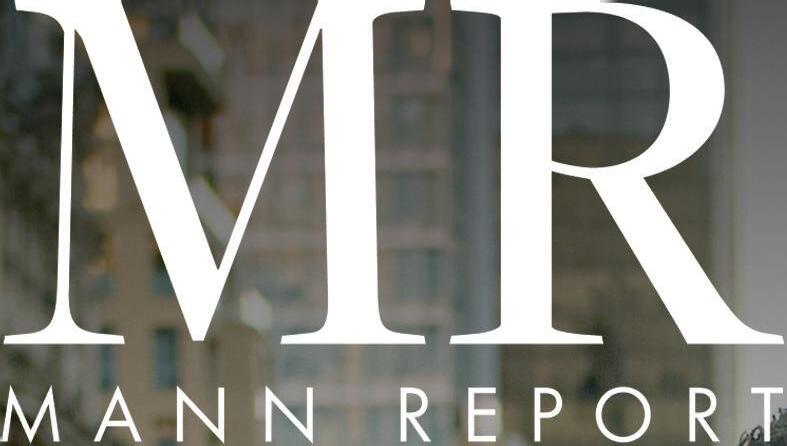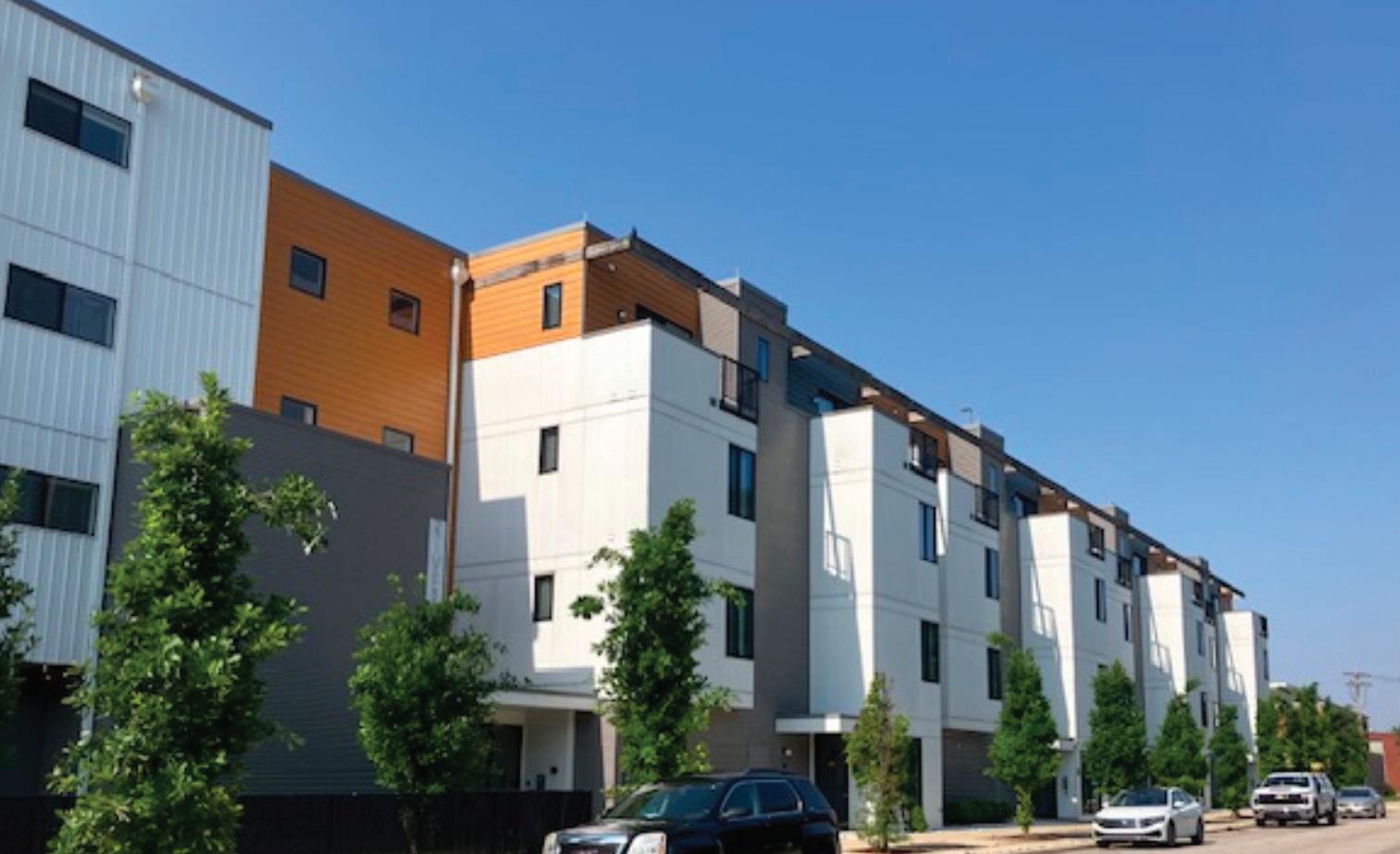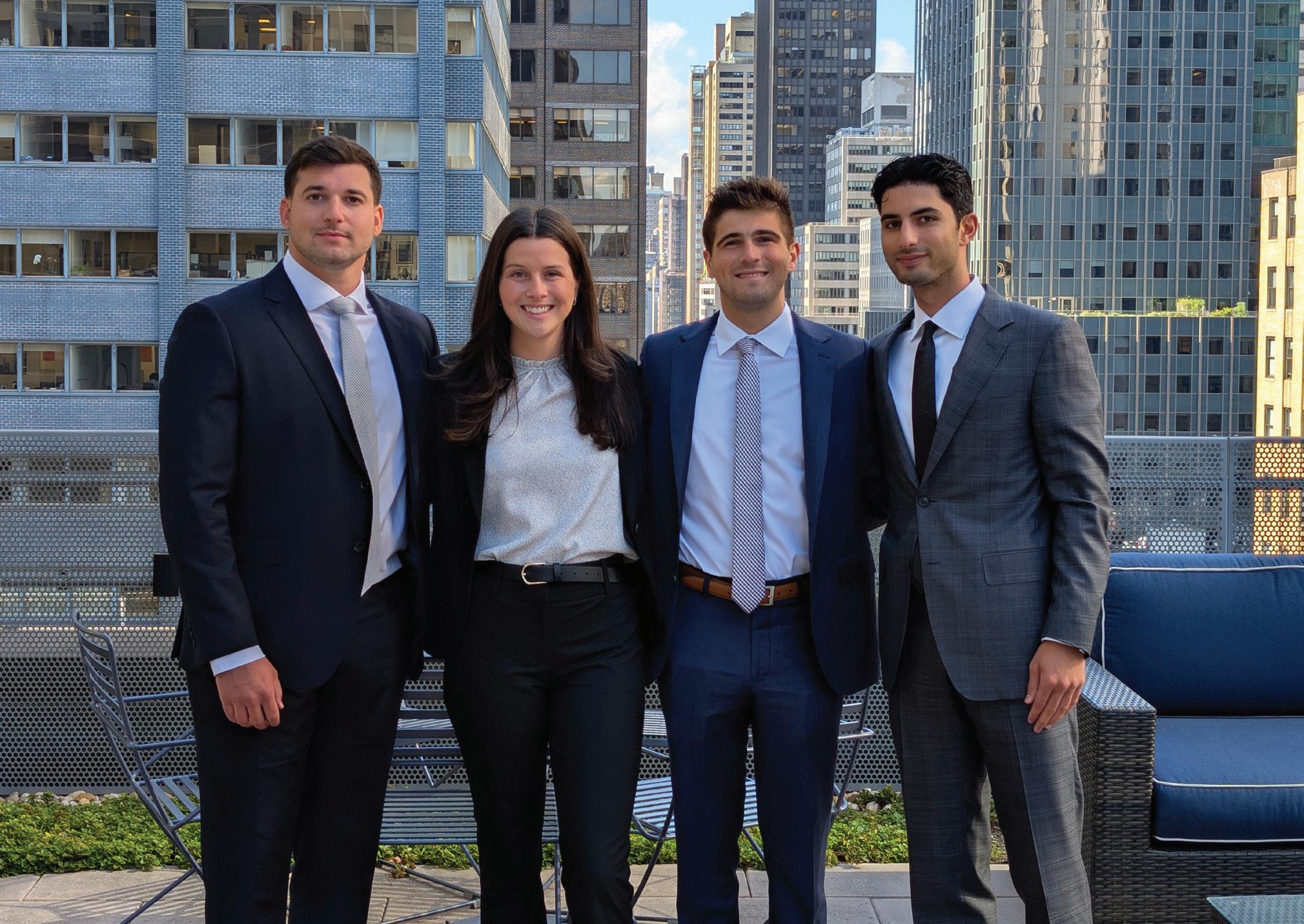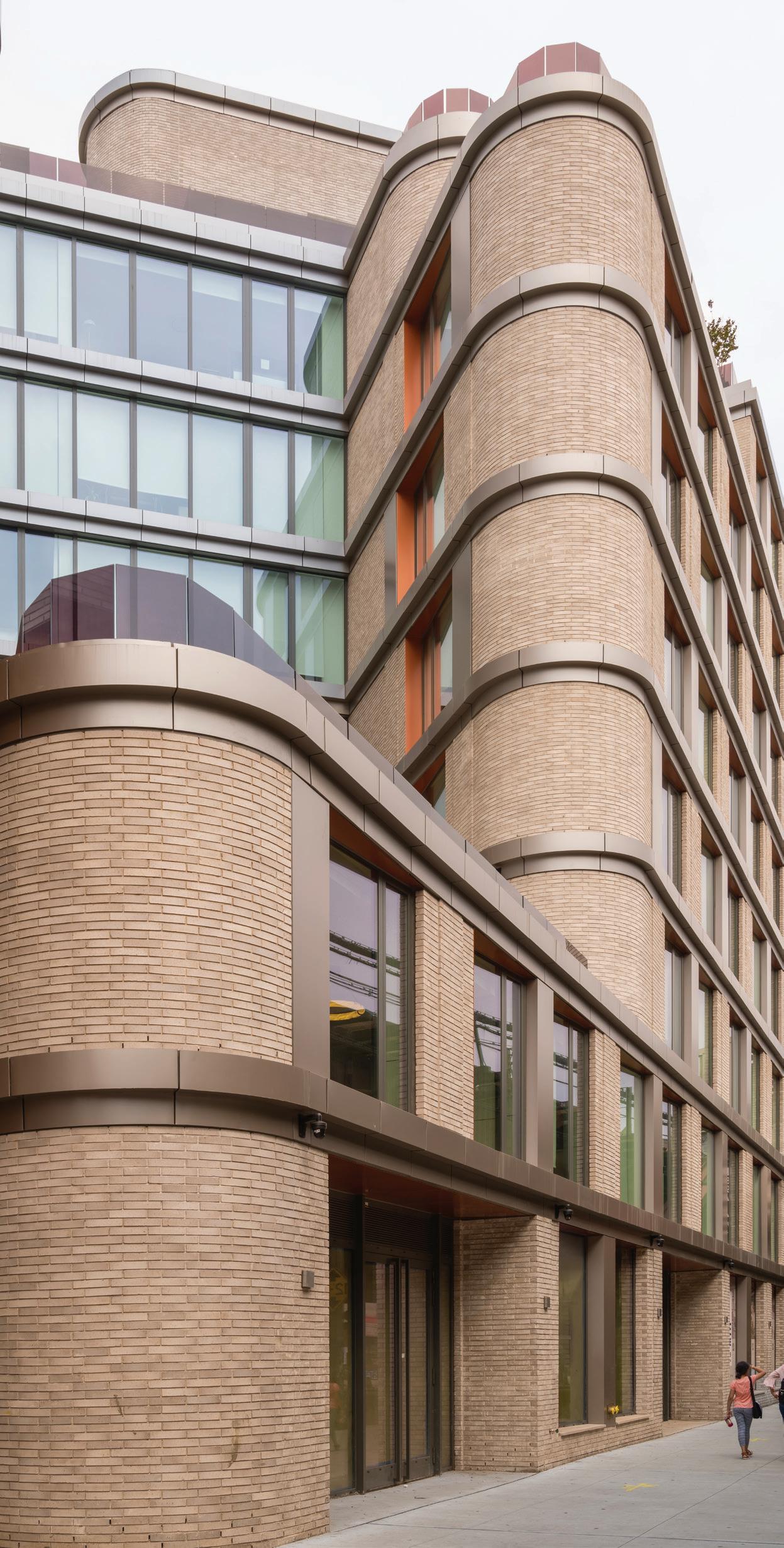












BUILDING A NEW CREDIT FUND AT INTEGRITAS CAPITAL


For decades, we have built a real estate practice unparalleled in the US. Now, as the global legal powerhouse HSF Kramer, we are so much more. As the only law firm ranked in Chambers Band 1 on three continents, we continue to transform skylines and reshape landscapes. Please visit our website to learn more. Kramer Levin is now HSF Kramer



































































































EDITORIAL
Editor
Debra Hazel
Director of Communications and Marketing
Penelope Herrera
Director of Newsletter Division
PRESIDENT/CEO
Jeff Mann
ART
Art Director
Virginia Sanchez
Cover Photography
Isaiah Gill
Frank DeLucia
Technology Consultant
Eric Loh
Cheri Phillips Distribution Mitchell’s Delivery Service
Michael Gifford
Eric Ives
Kris Kiser
Bob Knakal
Andreas Koutsoudakis
Kelly Kreth
Teresa Minnick
Oded Noy
James Philbin
Laura Rapaport
Ben Reinberg
Stuart Saft
Carol A. Sigmond
Fabio Zaniboni
DIGITAL MEDIA
Designers
Virginia Sanchez
Editors
Debra Hazel
Penelope Herrera
Rose Leveen
Cheri Phillips
Web Developer
CS Designworks
West Coast Office: 578 Washington Blvd., Suite 827
Marina Del Rey, CA 90292 866-306-MANN (6266) mannpublications.com




East Coast Office: 450 7th Ave, Suite 2306 New York, NY 10123 212-840-MANN (6266)


Ask someone about a typical real estate broker personality, and you’ll hear words like “extroverted,” “reactive” and “flexible.” Developers and bankers, on the other hand, evoke traits such as “stability,” “visionary” and "structure." It’s rare to find someone who combines them — but Stephen Palmese, our cover subject, embodies all.
A top broker for years at Massey Knakal, Cushman & Wakefield and JLL, Stephen has turned to his original plan with Integritas Capital, which both finances developments and creates new projects. It’s a fascinating portrait and a great way to cap the year.
Elsewhere, you’ll see the photos from the Mann Charitable and National Realty Club Foundations’ Annual Golf Outing. It was a great day of sport, dining and networking, with monies going to great causes. It’s my privilege to organize this great event.
And that’s it for 2025 — though as always, we’ll be publishing our weekly newswires throughout the next two months to keep you up-to-date on the latest news. Send us your news and ideas for 2026!
On behalf of the Mann family and the Mann Publications family, thank you for your support and loyalty this year. We wish you a holiday season of health, joy and peace.
We’ll see you next year!

“We all get the exact same 365 days. The only difference is what we do with them.” — Hillary DePiano






























































































Join us for an insightful evening featuring expert discussions on the latest advancements in Artificial Intelligence! Enjoy cocktails and a buffet as you connect with industry leaders and learn about the future of AI and its impact on consumer goods and real estate.
Don’t miss this opportunity to learn about the future of AI and its impact on these industries.

Date: December 1, 2025
Time: 6:00–9:00 p.m.
Location: Versa, 218 W 35th St, 7th Floor, New York, NY 10001
Registration Fee:
$250 (includes speakers, cocktails and buffet)
Keynote Speaker:


Agenda:
6:00p.m. – Cocktails and Networking
7:00p.m. – Keynote Presentation: Rob McGillen, “Transforming Consumer Goods and Real Estate with AI”
8:00p.m. – Buffet, Audience Q&A and gifts
Sponsorships available upon request

For more information and to RSVP, please contact:
Penelope Herrera pherrera@mannpublications.com 212-840-6266 ext.313
Michael Sacco, CPA Managing Director National Consumer & Industrial Products Industry Leader, CBIZ

Host:

Abe Schlisselfeld, CPA, EA Senior Managing Director National Real Estate Industry Leader, CBIZ
Jeff Mann, CEO President/CEO of Mann Publications

At Peninsula Property Management (PPM), we do more than manage properties—we elevate them. With a leadership team that is deeply involved, hands-on, and responsive, PPM is redefining the standard for property management in New York City. Our mission is simple: deliver results with integrity, precision, and a hospitality-first approach.

Proactive Management
Stop issues before they start — from Local Law 97 to vendor oversight.
Financial Clarity
Clean, timely financials. No surprises –just strategic planning and transparency.
NYC Compliance Expertise
DOB, HPD, LL88, LL97, FISP we navigate every regulation so you don’t have to.
New Development Services
Schedule B, TCO phasing, hiring of staff, punch-list, insurance implementation.
Smart Cost Control
Energy savings, bulk contracts, vendor negotiations we cut waste, not corners.
Track requests, tasks, and reports live through our integrated digital platform.
Well, it’s been quite a year. Amid constant discussions of tariffs, interest rates and proptech, I’m still trying to figure out where the last 12 months have gone. But now, in this year-end double issue, we see some predictions for the future, advice on staging and discussions of various aspects of artificial intelligence.
That’s what makes real estate so dynamic — it’s always evolving and always responding to the needs of its users. It will be fascinating to learn the retail sales results for this holiday season, and to see if year-end will see a rash of transactions.
It’s also time to express appreciation. Thank you to our readers, who inspire us to keep finding the best stories; our contributors, who share their expertise to advance our industry, and everyone in the Mann Publications family.
Whatever holidays all of you celebrate over the next two months, I hope they are filled with joy, family, good friends, health and peace.
We’ll see you in January.










More than 100 golfers enjoyed a day of sport, dining and networking at the first-ever joint Annual Golf Tournament hosted by the Mann Charitable Foundation and National Realty Club Foundation at the Fresh Meadow Country Club in Lake Success, N.Y.
This year specifically, the event was held in honor of the late Michael Kerr, former president of M&R Management, and a long-time supporter of both foundations. The honorees this year were Martin Efron, managing director at White Oak Commercial Finance, and Jaimee L. Nardiello, partner at Zetlin & DeChiara LLP. Mitti Liebersohn, CEO of brokerage operations in the Tri-State region at Savills, was the recipient of the Michael Kerr Humanitarian Award.
“Michael was a dear friend from my childhood, and his loss is a terrible one for our family and our industry,” said Jeffrey Mann, CEO and president of Mann Publications, principal officer of the Mann Charitable Foundation and president of the National Realty Club.
The Mann Charitable Foundation, established in honor of Irving and Marion Mann, supports research to fight life-threatening diseases including, but not limited to, Alzheimer’s Disease, heart disease, Crohn’s & Colitis, breast cancer and autism.
The National Realty Club Foundation, founded in 1947 by leading real estate owners, operators, builders and attorneys, facilitates industry education and networking and supports causes dedicated to improving the lives of all in New York City, including the Bronx Historical Society, Community Mainstream, National Jewish Museum, Jewish National Fund and Nassau County Law Enforcement.
Hadassah Nassau hosted a Day of Play for Israel at the Lake Success Golf Club, honoring Shari and Neil Garfinkel and Pam and Rich Krauss for their steadfast dedication to Hadassah and unwavering support of Israel. All enjoyed a day filled with games, golf, shopping with favorite vendors, eating, socializing and winning prizes!
Hadassah is the only level one Trauma Center in Jerusalem and serves as the official hospital for the IDF. Its multidisciplinary team is dedicated to a holistic approach to medicine, delivering hope and healing to the many casualties of the conflict. The advanced techniques
being developed at Hadassah will not only benefit its patients but will be shared worldwide,.
The organization has recently opened the state-of-the-art Gandel Rehabilitation Center. Construction was expedited in response to the terrorist attacks of October 7 and the organizaiton is continuing to fundraise in order to fully operationalize the center.
Its goal is to expand its services to a wide range of individuals in need, including terror victims, injured soldiers, stroke victims and those suffering from trauma, disease or accidents.








Top

Erald
Darlene
Norbert






$650,000


The Children’s Happy Faces Foundation, Marsh and Ronald McDonald House New York had a special day at its yearly charity golf and tennis experience, held at Sleepy Hollow Country Club and Trump National Golf Club. Happy Faces Guests were joined by the 3rd Annual Marsh Nine & Wine Golfers. Golfers at Sleepy Hollow were greeted with a bluegrass band and omelets overlooking the Hudson River.
In total, 296 golfers and tennis players and 100 donors gathered for dinner for the Networking Experience at the Mansion of Sleep Hollow Country Club, enjoying live music by the Parker Reilly Band to benefit Ronald McDonald House New York.
“The continued support from the New York real estate industry that directly benefits Ronald McDonald House New York is truly remarkable,” said Event Chairman
David Lipson, CEO and founding member of Children’s Happy Faces Foundation and senior managing director of Century Management Services Inc.
“For 45 years, Ronald McDonald House New York has provided needed support for the children and their families, with an incredible staff and dedicated volunteers offering daily programs for the children and their families,” Lipson said. “It’s truly their home away from home — the house that love and hope built on the Upper East Side of Manhattan; centrally located near the finest hospitals in the world, ensuring that families can be with their children while undergoing care. It is wonderful to see such an outpouring of love and support from so many.”
The Title Sponsor was Century Management Services Inc. The Platinum Sponsor was Andrew & Abby May Family Foundation.



Gold Sponsors were Efficient Combustion & Cooling Corp., Marsh LLC, Morgan Stanley, National Cooperative Bank, Ronald & Connie Perry and Spring Scaffolding LLC. Silver Sponsors were Bargold Storage Systems, C.A.C. Industries, DirecTV, Gallet Dryer & Berkey LLP, M&R Management and Scott M. Panzer Foundation. Bronze Sponsor were Daniels Norelli Cecere & Tavel and Mann Publications.
“We are grateful to the Children’s Happy Faces Foundation, Marsh LLC and all who have partnered with us to bring this year’s golf outing to life,” said Ruth C. Browne, president and CEO of Ronald McDonald House New York “The funds raised for this event are critically important in supporting our families as they experience the most difficult fight of their lives.”







Milestone event honors Robert C. Garrett, CEO of Hackensack Meridian Health, and raises funds for critical healthcare initiatives

Town Title Agency hosted its 10th Annual Golf Outing at the prestigious Ridgewood Country Club in Paramus. N.J. Organized by the Town Title Foundation, this year’s event marked a decade of charitable impact and community support, bringing together business leaders, healthcare advocates, and supporters for an unforgettable day of sport and generosity.
The outing began with a special presentation as Town Title and former New York Giants quarterback Eli Manning honored Robert C. Garrett, FACHE, CEO of Hackensack Meridian Health, with a signed event jersey. The gesture celebrated Garrett’s visionary leadership and dedication to advancing healthcare across New Jersey. Manning also marked his own milestone this year, celebrating 10 years with the Tackle Kids Cancer initiative.
All proceeds from the outing will benefit four impactful Hackensack Meridian Health programs: Tackle Kids Cancer at the Joseph M. Sanzari Children’s Hospital, Inserra Diabetes Research Institute at the Joseph M. Sanzari Children’s Hospital, Caryl and Jim Kourgelis Foundation for Behavioral Health at Hackensack Meridian Carrier Clinic and John Theurer Cancer Center.
These initiatives provide critical resources and support for patients facing cancer, diabetes, mental health challenges and other complex diagnoses, ensuring that care, innovation and hope remain close to home for New Jersey families.
“This 10th anniversary event was a milestone for the Town Title Foundation and a testament to the power of community,” said Christopher Rotio, executive vice president of Town Title. “We are proud to honor Robert Garrett, welcome Eli Manning, and support programs that make such a lasting impact.”

































large public universities with robust student communities. TSB Capital Advisors arranged financing for both transactions.
The team will develop two sites — one will be located on East College Avenue adjacent to the heart of the Penn State campus and the other on the corner of North Eagleville Road and Ledoyt Road, adjacent to the UConn campus core.



Liberty Mutual Investments (LMI), the investment firm for Liberty Mutual Group, and Landmark Properties (Landmark), a fully integrated real estate firm specializing in the development, construction, acquisition, investment management and operation of high-quality residential communities, announced joint ventures for the acquisition and development of two new student housing projects, The Mark State College and The Mark Mansfield.
The joint ventures will deliver 1,255 purpose-built, off-campus student housing beds at Pennsylvania State University (Penn State) and The University of Connecticut (UConn).
These developments represent the first venture between LMI and Landmark, leveraging Landmark’s track record of more than 20 years, while continuing LMI’s focus on investing in premier student housing opportunities. LMI’s student housing portfolio includes approximately 17,000 beds and is focused on adding purpose-built housing near
“These properties represent exceptional opportunities to deliver premier off-campus student housing at thriving universities — communities that will attract students and provide long-term value for residents,” said Christopher Finn, managing director and head of real estate at Liberty Mutual Investments. “We are excited to expand LMI’s student housing platform with Landmark, a leading developer of purpose-built, best-inclass student housing.”
The Mark State College, a 12-story student housing project serving Penn State students, will add 515 beds upon completion. Planned amenities include a skydeck, rooftop pool and hot tub with campus views, jumbotron, modern fitness center and sauna, clubhouse/amenity area, grilling area and fire pits, sports simulator, study lounge with café and computer lab, structured parking deck and bicycle/scooter parking. This is LMI’s third investment in student housing development within the Penn State market.
The Mark Mansfield, a nine-story student housing project serving UConn students, will add 740 beds. Planned amenities include a fitness center and clubhouse, sauna, nearly pool-sized hot tub, study lounge, computer lab, gaming lounge and bicycle parking.
“We’re excited about forging this relationship with LMI and look forward to working together on future initiatives,” said Walt Templin, president and chief investment officer of Landmark Properties. “Our shared commitment to providing housing options in university communities will help students excel in their academic careers while also reducing the pressure on the local housing market.”









to deliver flexible, fee-efficient access to high-quality real estate opportunities across the United States.
Designed to eliminate traditional fees and enhance alignment, RVAlliance provides access to high-quality, off-market real estate opportunities with a structure that prioritizes transparency, flexibility and capital efficiency. RVAlliance reflects Rose Valley’s core belief in combining a family-office mindset with institutional rigor, providing investors with a more aligned, transparent and attractive structure than traditional real estate funds.
“The right relationship is everything, and with RVAlliance, we’re building a unique platform that prioritizes investor capital while creating access to well-underwritten, cycle-tested real estate,” said Daniel Rosenthal, CEO of Rose Valley. “This is not just another fund — it’s an alliance between investor and operator and a better way to invest.”
RVAlliance stands out as a unique investment vehicle given its lack of vehicle-level fees and special upside through advantaged promotes that favor the investor, the firm continued.
Rose Valley offers RVAlliance investors access to off-market, value-add and opportunistic real estate deals. The firm’s approach is conservative, cycle-aware and focused on value appreciation and capital preservation.


Marty Burger of Infinite Global Real Estate Partners and Andrew Heiberger of Buttonwood Development, in partnership with 400 Capital Management LLC (400CM), have acquired 29 West 35th St., marking the first major offi ce-to-residential conversion under New York City’s new Midtown South Mixed-Use Plan.

The joint venture will introduce 107 boutique residences to the area, offering a distinct alternative its large-scale rental developments. Financing for the project was provided by Allegiant and 400CM, while additional equity partners include David Levinson of L&L and Terracotta Management. The project will serve as a blueprint for the district’s transformation by repurposing underutilized offi ce space into muchneeded housing as part of the city’s commitment to deliver over 10,000 new residences across Midtown South.
“New York City is home to some of the world’s most beautiful and iconic structures, many of which have outlived their original commercial purpose but possess incredible architectural character that deserves preservation. Rather than tearing these buildings down, we have an incredible opportunity to breathe new life into them as homes for New Yorkers,” said Burger. “This is a model example of adaptive re-use of an obsolete building in which we are creating much-needed housing — both affordable and market rate — in an ESG (Environmental, Social and Governance) compliant manner to create a residential enclave that will operate in a carbon neutral environment after its conversion. The city’s rezonings, led by the Mayor’s offi ce, City Council and City Planning, made this possible, and we are proud to be at the forefront of this transformation in Midtown South.”
The residences will consist entirely of studios ranging from 400 square
feet to 575 square feet, featuring soaring ceilings of 11 feet to 14 feet, designer kitchens, natural light and in-unit washer/dryers. Notably, 70% of the units will include fl exible spaces such as home offi ces, alcoves or bonus rooms.
The project utilizes the new 467-m real estate tax abatement program along with the Mandatory Inclusionary Housing program to create affordable housing units which will co-exist with market rate units, enabling the project to benefi t from a 35-year tax abatement program. Of the total units, approximately 75% will be market-rate, with 27 designated as affordable units at $1,701 per month through the inclusionary housing program.
An expansive rooftop amenity space will offer multiple seating areas, game tables and a large outdoor movie screen for films and sporting events, with views of the Empire State Building, NoMad, Hudson Yards and Bryant Park. Residents will also benefi t from a state-of-the-art security system, doorman and three elevators ensuring minimal wait times and maximum convenience. Additional amenities will include a dedicated pet wash station, bike and storage bins and a laundry facility with commercial-grade washers and dryers for oversized items.
“Midtown South is on the cusp of an incredible transformation, much like we saw in the Financial District, but with its own unique energy,” added Heiberger. “The neighborhood has it all — great energy, excellent transit access and top companies like Amazon and Salesforce anchored here — yet it lacks quality housing.”
The building is situated just three blocks south of Bryant Park and two blocks north of NoMad. Prime retail opportunities are also available at its base.
The developers were represented by Ben Schlegel of Ariel Property Advisors on the debt, lender Allegiant was represented by Richard Stanton, and the seller was represented by the Colliers team of Zach Redding and Matt Mastrocola. The project was designed by Ismael Leyva Architects. Archstone is the general contractor and project management services are being provided by L&L.

The Shop Workspace announced the official opening of its new Brooklyn location within 420 Carroll, a mixed-use development in the Gowanus neighborhood. The Shop is a design-forward coworking space tailored for freelancers, creative professionals and growing businesses rooted in the evolving Gowanus community. Offering 3,000 square feet of coworking space in the building’s second floor, The Shop at 420 Carroll will be the brand’s third location, with others in Salt Lake City and New Orleans. The Shop will soon open a new location in Greenpoint and plans to expand

with artists, nonprofits and local businesses. By blending high-touch hospitality with authentic community connections, we’ve created an ecosystem that makes people want to work here. Opening in Gowanus gives us the chance to welcome members into a space that reflects the neighborhood’s energy and creativity, while continuing to grow The Shop’s presence in New York. With a Greenpoint location confirmed, we are eager for continued growth across the city.”
The Shop offers pet-friendly offices, shared common areas, meeting spaces, cutting-edge technology, phone booths, a staffed reception area, mail and business services, an office kitchen, unlimited Beanmonger coffee, espresso, tea and more. Members of The Shop BK unlock access to over 100 coworking spaces across the globe through the League of Extraordinary Coworking Spaces (LeXC) and access to the Salt Lake City and New Orleans locations and any future locations of The Shop.



“At The Shop, service is far from an afterthought, it’s the core of our model,” said Anne Olsen, director of coworking at The Shop Workspace. “From Day One, we’ve designed this space around Gowanus. Our new location is rooted in our neighborhood through partnerships

Made possible by the Gowanus Mix zoning, The Shop is partnering with Arts Gowanus to offer subsidized space for local artists in addition to its commercial and reduced-cost Gowanus Mix community offerings. Seven Arts Gowanus studios have recently been awarded to local artists in a lottery system managed by Arts Gowanus, alongside five additional market rate Art Studios. A limited number of additional studios are available for leasing, starting from $1,881 up to $6,227.

totaling 79,775 square feet and eight commercial units spanning 4,385 square feet, which will remain after conversion. The site also features a 31,027-square-foot parking garage on the 1.61-acre parcel. The financing was arranged by loan originator Joe Siegfried, a member of the Eastern Union “President’s Team” under the leadership of company president and co-founder Abe Bergman.

Eastern Union, one of the largest commercial real estate mortgage brokerages in the United States, has secured $15.9 million in financing toward the condo conversion of River Rock Apartments, a five-floor, 82-unit, mixed-use property located at 116 West Mishawaka Ave. in Mishawaka, Ind.
Built in 2015 and 2016, the property includes 82 residential units
“This transaction supported the borrower’s business plan by securing the best possible full-leverage, interest-only financing,” Siegfried said in the announcement. “The loan structure gives the client sufficient time to sell off the condo units.”
River Rock Apartments features steel-frame construction with concrete, metal and fiberboard walls, along with interior entrances, a common area and elevator access.
The lender, Republic Bank, provided a three-year, interest-only loan with an 8% interest rate, a 75% loan-to-value ratio and no prepayment penalties. The borrower was not identified.
“One of Eastern Union’s core principles is to remain fully focused on our clients’ business needs,” Bergman said. “True to this commitment, Joe Siegfried has successfully arranged financing across a wide range of asset categories.”









Corcoran Group LLC continues to expand its domestic affiliates with the launch of Corcoran Plaza Properties, the brand’s first in New Mexico. Based in Santa Fe and led by Broker/Owner and CEO Rob Thorwald, the firm will serve clients across the city and surrounding areas up to the Colorado state line.
“Santa Fe is a premium example of refined living, where centuriesold heritage meets contemporary luxury,” said Pamela Liebman, president and CEO of The Corcoran Group. “Establishing Corcoran Plaza Properties in this market is a strategic milestone for our brand. The city’s allure, its architectural elegance, cultural diversity and breathtaking natural surroundings have long attracted discerning buyers seeking more than just a home. Rob Thorwald and his team embody the depth of local expertise and elevated service that defines Corcoran, making them the perfect stewards of our brand in this exceptional market.”
Founded in 1986 by Edward W. “Wally” Sargent, Santa Fe Properties has long been a top-performing and highly respected brokerage in
the region. Now operating as Corcoran Plaza Properties, the firm has grown to include more than 65 experienced agents, as well as support staff. In 2024, the company represented the sellers in the highestpriced home sale of the year, further cementing its reputation and skillset in the market’s luxury segment.
“Santa Fe is a wonderful place with a unique blend of cultures, arts, and the outdoors,” said Thorwald. “It’s a combination that has always drawn people here, and we’re looking forward to continuing to provide top-tier real estate services to our clients, now in affiliation with the excellence and prestige that the Corcoran brand embodies.”
Thorwald discovered the draw of Santa Fe in 1982 and moved to the area over a decade ago. Corcoran Plaza Properties will continue to serve clients interested in buying, selling and investing throughout Santa Fe’s key neighborhoods including Downtown/Eastside, Las Campanas, Monte Sereno, Eldorado and the Foothills, with a focus on high-end residential properties, farms, ranches and select commercial listings. The firm will continue to be based and operate out of its existing offi ces in downtown Santa Fe.
Santa Fe’s real estate market is characterized by high-value transactions, with the average sale price for homes within the most desirable areas easily surpassing the million-dollar mark. The city’s buyer demographic is predominantly domestic yet evolving, with an uptick in international interest. As a luxury resort destination, there is strong demand from second-home buyers and investors, particularly from markets such as Texas, California, Colorado, Washington, D.C. and the Tri-state area.
“Santa Fe’s unique blend of culture and natural beauty makes it one of the most compelling luxury markets in the country,” said Stephanie Anton, president of Corcoran Affiliates. “Rob’s leadership and the offi ce’s deep local roots align perfectly with the Corcoran brand’s values. We’re excited to help them elevate their business and support them in bringing our brand to life in New Mexico.”










Forbes Global Properties has added Junot, a family-owned firm based in Paris, to its international brokerage network. Junot will represent Forbes Global Properties across France and Belgium.
Widely regarded for its expertise in the sale of luxury properties and its
intimate knowledge of the Parisian market, Junot is backed by a team of more than 210 professionals and a network of 24 offi ces situated within the city’s most desirable neighborhoods.
“Junot’s reputation for excellence, discretion and local expertise makes them an ideal addition to our network,” said Michael Jalbert, CEO of Forbes Global Properties. “Their client-first commitment and long-standing market leadership refl ect the qualities we seek in every member, and we are proud to welcome them to Forbes Global Properties.”
Founded in 1984 and known for its expertise, in-depth market knowledge and client first approach, Maison Junot represents luxury real estate in Paris, Lille and Brussels through the integration of Victoire Properties.
“Forbes Global Properties allows us to offer our clients global visibility while staying true to our honored values and identity. We look forward to our continued growth across France, supported by an exceptional international network,” said Sébastien Kuperfi s, president of the Junot Group, in the announcement.
Forbes Global Properties provides branding and marketing services to premier real estate firms and is now represented by real estate agents across 29 countries in more than 600 locations. As members of this network, Junot will benefi t from Forbes’ engaged audience of more than 167 million to connect, inspire and inform affluent potential homebuyers and sellers about the finest properties for sale globally.

above-ask sale prices in most areas.
“Overall, the Q3 luxury market remains highly active, with fast absorption rates, limited supply and notable gains in high-end price bands. While median prices fluctuated slightly in some areas, strong demand and low inventory suggest continued momentum into Q4,” said Houlihan Lawrence President and CEO Liz Nunan.
Westchester County recorded 292 luxury sales (defined as more than $2 million) a 13% increase year over-year. Homes sold at an average of 104.4% of asking price, spending just 32 days on market.

The luxury real estate market across Westchester, Putnam, Dutchess and Fairfield Counties remained strong in the third quarter, with rising transaction volume, competitive pricing and robust demand, according to the “Houlihan Lawrence Q3 Luxury Market Report.”
Sellers continued to benefit from low inventory, fast-moving deals and
While the median sale price dipped slightly to $2.6 million, strength in the $5 million to $10 million segment and steady activity in the $3 million to $5 million range underscore sustained buyer appetite.
Putnam and Dutchess Counties posted a 61% jump in $1 million-plus sales in Q3. The median price declined 10% to $1.3 million, influenced by increased activity at the entry luxury level. However, homes sold quickly and competitively at 103% of asking. Greenwich, Conn. saw a 3% dip in sales but a median sale price increase of 11% to $4.8 million. The average price per square foot jumped 12% to $1,008. Homes sold faster and demand was strong.
Darien, New Canaan and Rowayton collectively experienced strong luxury activity in the quarter. Darien led with a 35% increase in sales, driven by a surge in $2 million to $3 million transactions. New Canaan followed with a 34% rise in sales while Rowayton remained steady. Across all three, homes sold quickly and often above asking.

Sentral, the Class A multifamily management company, announced the addition of three properties to its portfolio: a new development in Houston, and two takeovers — one in San Francisco and one in Alameda, Calif. Together, the three buildings add nearly 1,000 units to Sentral’s portfolio.
Located in Houston’s Museum District and slated to open in early 2026, the Houston project is a new development with 32 stories and 475 units, many of which will be designer-furnished. The building’s 60,000 square feet of amenity space will include a luxurious gym and yoga studio, state-of-the-art coworking spaces, pool, event lounge, restaurant and bar. The soon-to-be-named project is being developed by Raven Capital Management and RCM Living and will offer short-term stays and Sentral’s signature hospitality-inspired services and amenities.
“This incredible new project, which will include some of the best amenities in the market, was purpose-built for a group like Sentral — who has a solid track record of seamlessly operating buildings with both short- and long-term stays that attract residents and travelers looking for superb service and modern luxury,” said Noah Himmel, chief operating officer at RCM Living.
Star Harbor in Alameda offers luxury waterfront living inside a historic, 98-year-old former warehouse. Residents receive free transit passes, which include convenient ferry access to San Francisco and access to community amenities including a clubroom with kitchen, rooftop





and
Across the bay, in San Francisco’s Cathedral Hill neighborhood, the multifamily building at 830 Eddy St. offers sweeping city views and expansive floor plans with sleek design and modern appliances, Sentral said. Building amenities include a rooftop pool and lounge, coworking spaces and fitness center. With the addition of the two properties, Sentral now manages seven multifamily communities in the Bay Area.
830 Eddy is owned by the same institutional investor behind three other recently announced Sentral-managed communities — Reveal Playa Vista and 1600 Vine in Los Angeles, and 24Fifty at University Park in Denver.
A new study from Vector Solutions, a provider of safety, compliance and workforce readiness solutions for critical industries, has revealed the growing pressures construction supervisors face on today’s jobsites.
“The State of Frontline Safety Leadership in Construction” report, based on a survey of more than 600 full-time construction supervisors and managers across the United States, found that while supervisors feel accountable for both safety and culture, many say they lack the preparation and resources to deliver on those responsibilities.
Construction remains one of the most dangerous industries in the U.S., and has one of the highest suicide rates of any profession, according to the Centers for Disease Control and Prevention (CDC). Against that backdrop, the findings show how important it is for employers to better prepare supervisors to protect both safety and well-being on the jobsite. In fact, 93% say that structured supervisor training leads to fewer safety incidents. Yet, without stronger investment from leadership, supervisors are left in the dark to navigate hazards and sensitive crew issues.
The findings show that workers are increasingly turning to their supervisors for support that extends well beyond day-to-day operations: 71% of supervisors say a crew member has approached them with personal issues such as mental health or substance abuse.
Yet many don’t feel equipped to respond, as 64% worry that saying the wrong thing could make a worker’s personal situation even worse, and 38% admit that their company hasn’t provided them with clear protocols for handling these types of issues.
Even though supervisors aren’t always prepared when a crew member turns to them for help, they still recognize the responsibility they carry: 96% feel personally responsible for creating a safe, supportive culture on their jobsite and 95% believe their leadership directly reduces the

“Construction supervisors are carrying enormous weight for their crews, from managing safety and performance to supporting workers through personal challenges,” said Clare Epstein, general manager of commercial at Vector Solutions. “As the jobsite becomes more complex, supervisors need consistent training, clear guidance and accessible tools. We’re committed to providing the resources that help supervisors lead with confidence and keep crews safe.”
Supervisors are often left to make tough calls without backup, putting both safety and productivity at risk. Many say additional training would give them the confidence to respond more decisively when hazards arise. Two in three (67%) have had to make an important safety-related decision on site without clear guidance or support from their company and more than four in 10 (45%) have felt pressured to prioritize project deadlines over safety on the job.
Nearly half (49%) are concerned about burnout or mental health challenges among their team, but don’t know how to address it. Barriers to addressing these concerns include workplace stigma (33%), liability concerns (29%) and limited training (22%).

disassembled in roughly half the time of other conventional or luxury sidewalk shed systems, cutting both labor hours and street disruption at a moment when landlords and developers are facing new, stricter laws in the city governing how long sheds can be erected on street fronts.




New York City-based infrastructure design and distribution fi rm Shed announced the offi cial market debut of Halo, a modular scaffolding system aimed at rethinking how cities build — and experience — sidewalk sheds. Halo is set to be rolled out to contractors citywide, following successful pilots across high-traffi c corridors in Manhattan.
Engineered for speed, safety and simplicity, Halo combines a proprietary screwless, pin-based system with a refi ned structural aesthetic. Early installations show that Halo can be assembled and
“We designed Halo to complement urban environments and genuinely support contractors who need more control over how they plan and price their work,” said Marco Libani, co-founder of Shed Innovation. “Once we solved for ineffi ciencies in manufacturing and assembly, we were able to signifi cantly reduce downstream operational costs compared to other sidewalk shed systems on the market. And by offering Halo to contractors through a leasing model, we are enabling landlords to leverage their existing relationships, providing a level of trust and comfortability as they bid out and implement the new system.”
By removing the need for screws or fasteners, Halo’s modular structure allows for faster assembly with fewer tools and simplifi ed logistics. The system has been deployed at 210 Fifth Ave. and 1132 Broadway.
Halo’s design also promotes sidewalk visibility, a lighter street presence, and more reusable components — reducing waste and extending product life cycles.
“Halo refl ects a shift in how scaffolding can serve the needs of a modern city,” added Libani. “It’s modular — engineered to streamline contractor workfl ows while enabling property owners to elevate their street presence.”

hardware and labor expenses, and bring innovative access management to virtually any door — exterior, interior or exit.
“Our partnership with KoreLock allows us to bring powerful, connected access control to more businesses at a fraction of the cost,” said Kyle Henning, vice president of emerging capabilities at Levata, the parent company of the TrueSecure door lock brands. “The TrueSecure WP Series of Wi-Fi Direct locks is redefining how organizations deploy secure, remote access without the need for rewiring their buildings.”

KoreLock and Levata have introduced the TrueSecure WP Series, a lineup of six Wi-Fi Direct Smart Locks powered by KoreLock, delivering commercial-grade access control without the cost and complexity of traditional wired systems.
The TrueSecure WP Series provides secure, keyless access at up to 50% lower cost than conventional wired access control solutions, the companies said. These commercial Smart Locks install quickly, reduce
With TrueSecure’s streamlined installation and KoreLock’s turnkey wireless IoT technology platform, businesses can modernize their access control systems without major retrofits, new wiring or network infrastructure upgrades. The TrueSecure WP Series of Wi-Fi Direct Smart Locks includes six new models: Deadbolt, Grade 2 Lever, Grade 1 Lever, Exit Trim and Interconnected models, all of which are compatible with most commercial door lock applications.
Powered by KoreLock’s integrated IoT Smart Lock technology platform, TrueSecure WP Smart Locks feature BLE and Wi-Fi direct connectivity that operates securely over existing networks. Mobile credentials can be issued or revoked instantly from anywhere, providing unmatched flexibility for property managers, building administrators, and end-users.
“TrueSecure WP Smart Locks represent a powerful combination of innovation and practicality,” added Rob Goff, vice president of product and co-founder of KoreLock. “They make it easy for partners to increase profitability while providing customers with a secure, future-ready solution.”










Rental management software RentRedi announced the launch of its new AI-powered onboarding feature to make it easier and faster for landlords to set up their accounts and begin collecting rent by eliminating the manual data entry step of the onboarding process.
Landlords can upload their lease documents, and RentRedi’s advanced machine learning engine will scan the leases, extract key data (such as property addresses, tenant details, rent amounts and lease terms) and automatically populate their accounts.
“As with everything we do, this new AI onboarding capability helps landlords work smarter, not harder,” said RentRedi Co-founder and CEO Ryan Barone. “By removing the hassle of manual setup, we’re making it more seamless and effortless for landlords to get started, collect rent and grow their portfolios with confi dence.”
The AI onboarding feature is designed to remove friction and lower the barrier to entry for new customers. Key benefi ts include automating the extraction and inputting of lease data, cutting onboarding time from hours to minutes; easy set-up; precise data extraction, reducing errors from manual entry and accelerated rent collection with RentRedi’s full suite of tools.
“RentRedi was built for real estate investors who are building a path to fi nancial independence,” added Barone. “AI onboarding is one more way we’re making sure landlords can focus on their business, not their busywork.”

Zillow has become the only real estate app available in ChatGPT, giving people a first-of-its-kind way to begin their housing journey on the most widely used AI platform. The Zillow app in ChatGPT delivers listings, complete with photos, maps and pricing, and guides users back into Zillow to schedule a tour, connect with an agent or explore financing.
“As people increasingly turn to conversational AI to make their lives easier, Zillow is bringing that same simplicity to the home journey within ChatGPT,” said David Beitel, Zillow’s chief technology officer. “Our goal is to make it feel simple, intuitive and approachable. Partnering with OpenAI puts Zillow at the forefront of generative AI adoption; this builds on years of work as we continue to use AI to simplify and improve the path from searching for a home to actually unlocking the door.”
Zillow was an early partner that worked on building an app in ChatGPT, underscoring Zillow’s brand, scale and track record of turning technology breakthroughs into consumer-first innovations. This builds on decades of Zillow investment in AI, ensuring that consumers and the agents who guide them remain at the center of the journey.

The Zillow app in ChatGPT mirrors Zillow’s familiar design and is powered by Zillow’s housing insights, real-time listings and technology. Consumers see listing photos, property details, maps and pricing as well as broker and MLS attribution. Important next steps such as scheduling a tour, connecting with an agent or exploring financing will continue to flow through Zillow.
The experience supports most listing types, including rentals and homes for sale by agents or owners. Over time, Zillow plans to integrate newconstruction listings and immersive 3D tours.









Built, an AI-powered platform for real estate finance, has launched Built Payments with Lien Waivers, the first no-cost digital payments and lien waiver workflow for the construction industry. The solution is designed for everyone from general contractors and subcontractors to owners and developers. It allows businesses to send secure digital payments at no cost while automatically managing lien waivers in the same workflow whenever projects require them.
“This is a line in the sand. We’re designing low to no-cost solutions to help people pay and get paid faster and easier. With Built, making digital payments is free and lien waiver management comes built in. It is faster,
it is simpler, and once you experience it there is no going back,” said Chase Gilbert, co-founder and CEO of Built. “Built delivers a lightweight solution designed so that any builder, from the largest GC to the smallest subcontractor, can get up and running the same day.”
Construction finance has been weighed down by paper checks that take days to clear, lien waivers that arrive late or incomplete and reconciliations that consume hours at month-end. These delays stall projects, frustrate vendors and owners and leave back-office teams carrying the burden of extra work just to keep payments moving.
For the first time, any construction business can pay payables for free with digital payments and, if required, attach lien waivers in one simple workflow. Built processses payments and automatically generates lien waivers tied to each disbursement, ensuring compliance without extra steps. Payment recipients can optionally elect even faster access to their money for a small fee.
Finance teams gain real-time visibility into cash flow and project status without relying on duplicate systems, manual tracking or hidden fees. At the same time, subcontractors receive payment for free when they expect it, general contractors reduce overhead and avoid delays, and owners and developers gain confidence knowing that every downstream vendor is being paid to keep their project moving forward.
Any firm can send unlimited digital payments through Built at no cost, with lien waiver management automatically included for free. Payment recipients never pay to access the system or receive digital payments but can optionally choose to receive funds even faster for a small fee.

















Real estate experience platform HqO announced the launch of the CRM for CRE, a purpose-built system for experiential landlords to manage tenant relationships, unify operations and close the experience gap across commercial real estate portfolios.
The unified platform will transform how landlords earn, retain and grow tenant business beyond the lease, the company said.
“Tenant expectations have outpaced traditional operating models, and transactional ownership is no longer enough,” said Chase Garbarino, CEO and co-founder of HqO, in the announcement. “Landlords who
deliver outcomes, not just space, are the ones who will thrive. The CRM for CRE gives them the infrastructure to do exactly that. It is the system of record and action that enables experiential landlords to finally operate in a customer-centric way.”
HqO’s CRM for CRE unifies leasing, operations, experience and intelligence in one cohesive platform. By consolidating tenant data, automating workflows and surfacing actionable insights, the system empowers property and asset teams to drive performance and loyalty at scale.
New enhancements to tenant lifecycle management, intelligence and operations in the Fall 2025 release bring disconnected processes and technologies into a connected ecosystem. Key capabilities include centralizing profiles, lifecycle-based navigation and omnichannel workflows; real-time analytics; multichannel communication, event management and engagement management tools; integrated access, visitor, resource booking and service request tools; a flexible monetization engine and an AI-ready foundation.
“This release represents the next chapter in how landlords operate,” said Shelly Just, senior vice president of client strategy and operations at HqO. “We’re giving property and asset teams a true CRM that unites data, workflows and intelligence across the entire tenant lifecycle. When paired with an experience program like HqOX, asset owners can build the deep loyalty and financial returns their investors demand. It’s about running real estate portfolios like modern customer organizations, intentionally, insightfully and at scale.”


With over 75 years of experience and deep understanding of industry challenges, IDB’s Commercial Real Estate team supports property owners, developers and builders across every type of financing requirement. We can help you keep pace with changes in the marketplace, while maintaining high credit quality levels and providing the personalized service, efficiency and flexibility to fit your specific needs.
For more information about financing solutions that meet your specific needs, visit idbny.com.










Derby Lane Partners has launched as an alternative investment management firm with up to $1.8 billion committed across the platform from the strategic anchor partners.
Derby Lane Partners said that it will provide flexible, creative capital solutions to the market across asset classes, with an initial focus on the compelling investment opportunity in commercial real estate credit in North America.
Strategic anchor partners include BTG Pactual, funds managed by affiliates of Fortress Investment Group, Koch Real Estate Investments, Liberty Mutual Investments, Silver Creek Capital Management and Stable.
Adam Piekarski, Derby Lane’s founder, chief executive and chief investment officer, brings to the firm over two decades of investment experience across public and private markets in commercial real estate credit, corporate credit and private equity.
He most recently served as the co-head of real estate credit at BDT & MSD Partners, where he co-founded and led the buildout of the investment team and the deployment of more than $5 billion of capital for commercial real estate credit investment strategies.
“Today’s market presents an attractive opportunity to invest in commercial real estate debt. We have assembled a seasoned team, paired with flexible capital and a differentiated approach to the market, that positions our firm to play offense while others continue to play defense,” Piekarski said in the announcement. “As we strive to drive value and sustainable performance across market cycles, we will always remain focused on our disciplined credit process and proactive asset management with our partners.”
In addition to Piekarski, the initial senior members of Derby Lane include Partner Kory Klebanoff, previously the co-head of East Coast originations at ACORE Capital, and Urian Yap, partner and CFO, previously the CFO of Madison Realty Capital. Klebanoff will be joined on the investment team by Matt Doneth, managing director, previously at Apollo Global Management, and Heecheol Pak, managing director, previously at Blackstone.

RFR announced that workplace experience company Industrious has committed to taking 33,231 square feet of space at 190 Bowery, a 38,000-square-foot landmarked office building located at the corner of Spring Street and Bowery in the NoLita neighborhood of Manhattan.

“The building itself is an evolving work of art situated in the heart of one of the city’s most vibrant neighborhoods,” said AJ Camhi, executive vice president and director of leasing of RFR. “It represents a one-of-a-kind opportunity for Industrious to provide a curated workplace experience in one of New York City’s most storied spaces.”
RFR was represented by an in-house team of AJ Camhi, Paul Milunec and Rob Weller along with Alexander Riguardi, Clark Finney, Robin Olinyk, Dana Goldman and Jake Bargas of JLL. Industrious was represented in house by Natalie Levine, director of real estate, and Kylie VanBuren, director of real estate transactions.
“We’re excited to plant our first flag for Industrious in this pocket of Manhattan,” Levine said. “While we have a strong presence across the city, this space is a trailblazer for our footprint in the walkable, energetic NoLita and Lower East Side area. The building’s architecture and fascinating history make it an inspiring setting. It’s a natural fit for the thoughtful, hospitality-driven workplaces we’re known for.”
Built in 1898 and designed by architect Robert Maynicke, 190 Bowery is a Beaux-Arts building which was commissioned by The Germania Bank and included a grand banking hall and offices above. Germania and its successor banks operated at the building until its sale to photographer Jay Maisel in 1966. Maisel maintained his residence, studio and gallery at the building for nearly 50 years – he also hosted his wedding and raised his daughter in the building. Maisel notably rented out the fourth floor as studio space to American pop artist Roy Lichtenstein.
The building became a mecca for street artists over the years and famously would get covered in chalk by Keith Haring. The building had an aura of mystery with this unique counterpoint of Gilded Age architecture contrasting with graffiti.
When RFR acquired the building in 2015, the firm kept the periodspecific architectural details in place which had been virtually untouched by Maisel. RFR updated the building systems throughout allowing the building to gain the functionality and comforts of a modern office building. RFR even relocated the building’s original copper cage elevator to the second floor where it serves as a private phone room.
The rooftop water tower, which is highly visible from the street, features a mural by artist Shepard Fairey called “Power and Equality” with a portrait of actress Rosario Dawson, who grew up in the neighborhood.



In today’s fast-moving and increasingly complex financial environment, successful business owners need more than just an advisor—they need a trusted partner who sees the full picture, anticipates change, and integrates every facet of their financial world. For over 30 years, Louis C. Ciliberti & Associates has delivered exactly that.
We are a full-service financial firm and multi-family office that helps the most financially successful individuals and privately held companies in the nation. At Louis C. Ciliberti & Associates, we don’t just provide advice—we orchestrate and execute a total wealth strategy that aligns with our clients’ business goals, family needs, and long term vision.



FirstService Residential, one of the largest residential property management companies in North America, has promoted Marc Kotler to president of New York City.
Kotler’s elevation will position him to continue to expand FirstService’s offerings and growth in the city.



Kotler brings more than three decades of property management expertise to his position, having joined FirstService Residential in 2004.
Over the years, he has held a variety of leadership roles within the organization, most recently serving as president of the New Development Group, New York, at FirstService. During his tenure, he played a key role
in building the division into the industry’s top consultant and manager for luxury high-rises, co-ops, condominiums and multifamily developers and institutional investors, making a lasting impact on New York City’s residential landscape, the company said.
As president of New York, Kotler will lead a team managing a diverse portfolio of properties that includes luxury high-rises, rental multifamily buildings, cooperatives, HOAs and condominiums from Manhattan, Brooklyn, Queens, Staten Island, The Bronx, Long Island and Westchester County.
“Marc’s comprehensive knowledge of property management and his proven leadership make him the ideal fit to lead our New York City operations,” said John Brea, president of the North Region at FirstService Residential. “His dedication to service excellence and his deep understanding of the market will help drive continued growth while elevating the client experience in New York.”
Kotler has been involved in the development and management of some of New York City’s most iconic properties, including The Plaza, 432 Park Ave., The Baccarat, 8 Spruce Street (NY by Gehry) and, more recently, 277 Fifth Ave., One Wall Street, 53 West 53rd St. and 520 Fifth Ave.
“I am dedicated to leveraging our unmatched local talent and expertise to deliver superior service that consistently exceeds the expectations of our clients and residents,” Kotler said.

Bungalow Projects, a real estate development firm focused on creating production hubs for episodic, film and digital content creation, and Bain Capital Real Estate announced the successful closing of $304 million in construction financing to aid the development of Echelon Studios, two high-end film and television production studios in Brooklyn, N.Y.

CounterpointeSRE provided a $156 million Commercial Property Assessed Clean Energy (C-PACE) financing to support the project’s sustainable development efforts, representing the largest C-PACE transaction in New York State and first-ever C-PACE financing for ground-up development in New York City. An affiliate of Farallon Capital Management provided $147 million in additional financing.
Combined, the two Brooklyn developments will result in approximately 600,000 square feet of production space across 10 state-of-theart soundstages, top-tier production office and support spaces and significant below-grade parking. With 40-foot clear-to-grid heights, the
purpose-built soundstages will offer column-free space with marketleading electric, HVAC, floor load and acoustic specifications designed to meet or exceed modern-day production requirements.
“We are excited to move forward on developing these state-of-the-art facilities that will cater to all types of episodic and film production and fill New York City’s undersupply of purpose-built stages that are critical to the growth of New York’s content production ecosystem,” said Travis Feehan, co-founder of Bungalow Projects.
Located at 242 Seigel St., Echelon Studios Bushwick will comprise six stages totaling 102,000 square feet of stage space, 86,000 square feet of production support space, 76,000 square feet of production office space and 91,000 square feet of below-grade parking for over 230 spaces.
Echelon Studios Red Hook is located at 176 Dikeman St. and will comprise four stages totaling 67,000 square feet of stage space, 75,000 square feet of production support space, 49,000 square feet of office space and 55,000 square feet of below-grade parking.
“We are grateful for the support we received from our lending partners and look forward to their continued support as we break ground on these cutting-edge and sustainable projects that will expand the realm of opportunities for New York City’s vibrant film and television production industry,” said Susi Yu, co-founder of Bungalow Projects.
Both projects are slated to be completed in mid-2027. Productions filming at Echelon Studios will benefit from the recently expanded New York State Film Tax Credit Program, which provides $800 million in annual incentives through 2036. Bungalow Projects and Bain Capital have a joint venture focused on investing in and developing sustainable and cutting-edge production hubs in New York City.


By Debra Hazel
Once a broker, always a broker? Not so for Stephen Palmese, who has taken the lessons learned at some of New York City’s top commercial real estate brokerages to inform his shift into financing at Integritas Capital, a vertically integrated investor and developer, as well as a direct lender.
Since 2004, Integritas Capital and its predecessor firm have been the direct developer of more than $1 billion in real estate transactions and lead investor in more than $2.5 billion in real estate projects across ground up development, direct investment and preferred equity investment, the acquiring of non-performing loans and the origination of whole loans and mezzanine financing. And it’s ramped up quickly, originating $800 million in loans in the past 18 months.

“Typically, building a business can take a decade,” said Palmese, Integritas founder and managing principal. “Buying and lending during a downturn, we knew we could build a company in a shorter time frame.”
Real estate development had always been his plan, even as a child wandering the city with his father looking at skyscrapers. The youngest of four children, Palmese grew up with real estate in his blood — some 90 years ago, his grandfather was a homebuilder who eventually transitioned his business to servicing multifamily and office buildings.
“In college, if you’d asked what I wanted to do, it was real estate development,” he said.

After graduating from Georgetown University in 2004 with a degree in international finance and business management, and having studied foreign exchange at Oxford University, Palmese found that opportunities in real estate development were scarce. Despite his strong academic background, he was also hesitant to join the family’s business.
An introduction from his now sister-in-law to Massey Knakal’s Jonathan Hageman brought him to commercial real estate brokerage, even as development continued to be his long-term plan.
“I met Jon and Bob Knakal with the idea of learning the business for a couple of years, and when I was ready to move into development, I’d do that,” Palmese said.
Circumstances, however, kept intervening.
“I started in August 2004. Then with the Great Financial Crisis of October 2008, when I was ready to move from brokerage into development, there were no jobs,” he said. “That was my inflection point. I should have taken a risk and started my own development company then.”

Meanwhile, Palmese, born in Brooklyn but raised in Staten Island, established Massey Knakal’s Brooklyn office — long before the borough became the “cool” place in the city. He quickly became an expert in the borough, facilitating transactions including the $345 million sale of 85-89 Jay St., the $340 million sale of 25-30 Columbia Heights and the $90 million sale of 9 Dekalb Ave.






His goal at that point was to build his visibility in brokerage prior to moving into development. Yet even as the market rebounded, Palmese remained with Massey Knakal, becoming a partner in 2012.
“Working at Massey Knakal was a such wonderful situation that you didn’t realize you were in a snow globe,” Palmese reminisced. “What kept me close to brokerage longer than I planned was the culture Bob and Paul created at Massey Knakal.”
But the idea of owning a portfolio of his own remained with him, and he founded Legacy Equity Holdings, a reboot of a long-inactive family business, to begin purchasing multifamily buildings, carefully avoiding conflicts of interest by acquiring through other brokers.
“The market was still dislocated, and I received a call from Marcus & Millichap asking if I’d buy an eight-family on Atlantic Avenue,” he said. “I knew I was the broker’s last call — because I’d told him to put me at the bottom of his list. And that’s exactly what he did — and we ended up buying it. That began the relationship and was where Legacy came from.”
He focused on acquiring small midcap buildings in Brooklyn and Queens, building a portfolio of 20 buildings over five years that Legacy would renovate and manage in then-unknown neighborhoods such as Crown Heights and Boerum Hill, Brooklyn until rent laws changed. Legacy stopped acquiring in 2018.
surprising at all that he is as successful in his new career as he was as a top producer in the brokerage business. I am so proud of his tremendous success.”
But working at publicly traded companies just wasn’t the same. The 2020 onset of the COVID-19 pandemic, which disrupted the local real estate market in so many ways, also pushed Palmese to rethink his own path, looking to pivot from multifamily into a new business line.
“During the summer of COVID, I realized that a Brooklyn brownstone that sold for $2 million in the Great Financial Crisis in 2010 or 2011 would now go for five times that,” he said. “I looked in the mirror and said ‘I’m not going to miss another opportunity to capitalize on that.’”

Other changes were taking place in his professional life at the same time. Massey Knakal was acquired by Cushman & Wakefield in 2015, and Palmese followed most of the team to the new firm, then again to JLL when Bob Knakal moved over there. (Knakal and JLL parted ways in 2024 and he has since founded BK Real Estate Advisors.)
“Stephen has always been a tireless worker who really understood the business from his first days. He was a great partner, always gave it his best effort, was extraordinarily likable and achieved great results for his clients and for our company,” said Knakal. “It is not
With partner Heights Advisors, an experienced developer and contractor and mentor from his earliest days in the business, he bought some strategic assets outside of New York in summer 2020 and 2021 and built momentum harvesting those projects as well as land with easements, lawsuits and environmental risks. After creating that portfolio, Legacy added lending, including direct loans. In 2023, he rolled all of that into Integritas, a direct investor, developer and lender. Legacy continues to own the multifamily buildings he acquired a decade ago.
“Where I am today is the culmination of the efforts that took place back then, inclusive of lending and direct investment and developing,” he said.
Today, Integritas — a key concept in the Spartan military meaning completeness, wholeness or soundness — provides loans of $25 million to $300 million, including bridge loans, construction loans or acquisition loans. Terms are slightly higher, but Integritas’ small size (just four staff, including Palmese) allows for quick decision making — he and Managing Director Michael Ottomanelli consult with partner Heights.

On the acquisition side, the firm focuses on properties that are in periods of dislocation, he said, such as the deeply distressed projects it acquired in 2020 and 2021, as well as projects it acquired

“These people know I foow through with what I say. YOU MAKE FRIENDS OVER TIME, AND I CERTAINLY KNOW HOW TO WORK WITH BROKERS.”
—Stephen Palmese

in Florida in 2018, where the upside at the time was greater than in New York.
“We’re not common equity — we’re not giving cash to another developer,” he explained. “We’re only buying to develop ourselves if it’s compelling. The strategies are complementary.”
That philosophy dates back to Palmese’s Massey Knakal days, when he was encouraged to not just be expert in the city, but to individual streets — and the projects on them.
“Fort Lauderdale was where the opportunities were,” he said. “Now, today, the opportunities are elsewhere.”
His background in commercial brokerage comes in handy.
“We take a bit of a different approach at Integritas,” Palmese observed. “When we issue a construction loan, we want to meet the subs and learn their pricing and sourcing. We comment on the plans, floor by floor.”
And all those years working with all of those owners mean a hefty network.














participate in their loans. And so, we put out a lot of money, partnering with companies who invited to participate as well as originating our own loans.”
Recent transactions include a $125 million construction loan to convert a Brooklyn office building at 175 Pearl St. into residential; an $18 million construction bridge loan to advance predevelopment in Queens, a $96 million loan to develop a condominium in Fort Lauderdale, a $53 million refinancing of a Red Hook, Brooklyn site that will house an industrial development, and a $155 million bridge loan to convert a 50-story, 466-unit Miami multifamily into the Miami Flow House condos.







“Going back to the Massey Knakal days, I can get to pretty much anyone in New York City with one, or maybe two, phone calls,” he said. “It’s also helped with authenticity. These people know I follow through with what I say. You make friends over time, and I certainly know how to work with brokers.”
Integritas has raised private capital on the lending side and is now in the position to grow its institutional business. Over the last 15 months, it’s loaned $800 million, with an average loan size of $80 million. Future opportunity is huge.
“In 2024, it ended up being a special point in time,” he said. “Many of the debt funds were tending to legacy books with loans from 2021 (and prior). Those loans were very low interest rate, and they had to adjust to the changes in value. They weren’t actively originating new loans. We came into the market with $100 million in cash. I was getting phone calls from debt funds asking if we were able to














Integritas also is proposing a 57-story tower with apartments and a hotel in Fort Lauderdale.
After spending time supporting multiple charities over the years, Palmese has chosen more recently to focus his energies on two organizations — Laugh it Out, an organization that brings improv comedy to inner city schools, and World Without Exploitation, a coalition that is dedicated to eliminating human trafficking.
“With Laugh It Out, you see these adolescents — the so-called bully, the jock, the nerd, all of these social categories — on stage, and that’s the equalizer,” he said. “Improv unifies everybody, and studies show that these kids are less likely to be susceptible to gang violence and have higher graduation rates.”
Integritas is also raising its first fund, with investors likely coming from high-net-worth families. The number of distressed projects is likely to increase as loans originated in a much lower interest rate environment come due. And that diverse experience will continue to benefit the company.
“I’ve bought multifamily and renovated multifamily,” said Palmese.“I have yet to build anything from the ground up, but my partner, Heights, has this experience. Now, as we’re doing large-scale loans, between lending and investing, this is how we’ll be able to scale.”




Zetlin & De Chiara LLP, one of the country’s leading law firms, has built a reputation on counseling clients through complex issues. Whether negotiating a contract, resolving a dispute, or providing guidance to navigate the construction process, Zetlin & De Chiara is recognized as a “go-to firm for construction.”



By Ben Reinberg, Founder and CEO, Alliance Consolidated Group of Companies
Commercial real estate (CRE) heads into 2026 with a new operating manual. Capital is selective, tenants prize flexibility and experience, and technology is now nonnegotiable. Meanwhile, geopolitics, especially tariffs, are shaping where companies expand and where investors follow. In this environment, the edge goes to owners and operators who demonstrate value in terms of cash flow, transparency and execution, not promises.
The next year won’t reward optimism; it will reward operational excellence. Below are seven 2026 predictions that capture where the market is going and how investors can prepare.
1. Cash Flow Is King
Inconsistent reporting will disqualify deals; transparency is now a baseline expectation. Deals that pencil on Day One beat pro formas that assume tomorrow’s growth. Limited partners will push for monthly reporting, including rent rolls, collections, variance to budget and aging accounts receivable (A/R). Operators who show consistent net operating income (NOI), disciplined expense control and scalable playbooks will command capital. Appreciation-only theses face a higher bar.
2. Hybrid-First CRE
Office and mixed-use assets that aren’t engineered for flexibility and tech integration will lag behind. Tenants want rooms that convert, robust connectivity and spaces that support both team time and individual focus time, often on the same day. In 2026, tenant-experience
strategists, not brokers, will drive value in office and mixed-use assets. The most valuable CRE professionals won’t just be dealmakers; they’ll be tenant-experience strategists who align design, amenities and services with how people actually work and can prove it in renewal rates.
3. AI Becomes Standard
Expect investors to ask: What models were used? What data trained them? How did AI shape pricing? Underwriting, tenant evaluation and real-time risk modeling will run on data engines that learn and iterate. Expect investors to request AI transparency in diligence: what models were used, which inputs drove the conclusions and how the outputs influenced pricing or structure. Teams that pair human judgment with machine speed will make sharper, faster decisions.
4. Inflation Normalizes, Clauses Harden
Even if inflation settles in the 3% to 4% range, lease language won’t soften. Annual escalations, stronger expense pass-throughs and tighter insurance/tax provisions will be standard. Owners who systematize renewals and standardize riders will keep income aligned with costs without slowing lease velocity. Tenants will accept clarity when it’s paired with better service and predictable operating expenses (OPEX).
5. Creative Debt Structures Rise
With rates elevated, floating-rate debt only works with caps or outsized cash flow. Middle-market deals will rely on seller



financing, joint venture (JV) equity and mezzanine tranches to bridge the gaps.
In 2026, debt creativity isn’t optional; it’s a survival skill. This stack adds complexity and opportunity for disciplined operators. Stress-test debt service coverage ratio (DSCR) under multiple interest-rate paths, hedge where appropriate and build optionality into maturities so you’re not forced to refinance on a bad day.
6. Tariffs Reshape Geography
Trade policy will matter more in site selection. Original equipment manufacturers (OEMs) will steer production to second-tier manufacturing markets where states offer aggressive incentives and logistics are favorable. Investors will follow with capital for modern industrial, workforce housing and supporting retail. Expect rising demand along supply-chain corridors that used to be “flyover” on national maps.
7. Manufacturing Anchors CRE Demand
Reshoring and clean-tech production will keep the industrial sector in the spotlight. Secondary manufacturing zones will see outsized absorption as plants come online and suppliers cluster nearby. Secondary metros will benefit first, especially where infrastructure and a workforce already exist. Data centers, logistics hubs and repositioned legacy retail will be absorbed into the supply chain. For diversified portfolios, this becomes the spine: dependable rent rolls tied to real production.
Proving value is the cost of capital in 2026: Prove it in the numbers and through experience. Underwrite acquisitions conservatively, assume realistic hold periods and plan multiple exits.
On operations, lean into tenant experience (fewer friction points, better communication and faster service) and demonstrate it in key performance indicators (KPIs) like renewal probabilities, blended rent growth and work order service-level agreements (SLAs). On capital, prepare for deeper diligence: clean data rooms, consistent monthly reporting and clear visibility into risks and mitigations (rate caps, expense management, rollover maps).
The practical next steps include:
• Recasting underwriting around in-place cash flow, not best-case mark-to-market.
• Standardizing leases: annual bumps, pass-through protections and escalation mechanics that keep pace with cost lines.
• Codifying your debt playbook with hedging guidelines, seller-finance templates and joint venture structures you can execute quickly.
• Operationalizing tenant experience: technology uptime, response times and amenity activation that shows up in renewals.
• Watching the manufacturing map: Freight lanes, incentive zones and supplier clusters will indicate the next industrial hot spots.
Opportunity Before
Cycles reward preparation. As AI reshapes diligence, tariffs redirect growth and leases become more stringent, the winners will be the teams that adapt quickly and execute with discipline. Build around cash flow. Design for hybrid work. Standardize your debt stack. Keep an eye on where production is headed. Do that, and 2026 won’t feel like a headwind; it will read like a roadmap.













By Laura Rapaport, Founder and CEO, North Bridge
2025 marked a turning point for the commercial property assessed clean energy (C-PACE) industry, defined by record-breaking deal volumes, expanding use cases and broad regulatory support.
What was once a niche financing mechanism has become a mainstream capital markets solution, with cumulative C-PACE financings surpassing $10 billion and transactions now reaching into the nine figures.

The year saw major growth in new construction and large-scale repositionings, the rollout of new programs in states like New Jersey and Idaho and the expansion of existing ones in New York City and Texas. Lender adoption hit new highs, spreads continued to compress, and institutional sponsors increasingly incorporated C-PACE into their capital stacks from the outset. Together, these milestones cemented 2025 as the year C-PACE truly scaled — and set the stage for an even more accelerated 2026.

According to PACENation, cumulative C-PACE financings surpassed $10 billion by mid-2025. What was once a niche tool has now become a mainstream financing mechanism, with transactions ranging from $5 million to more than $250 million.
Retrofits continue to represent an important share of C-PACE financing, particularly as local laws such as New York City’s Local Law 97 drive demand for energy upgrades. But the most notable shift in 2025 was the rise of new construction and major repositionings. New construction, which was unheard of in C-PACE until five years ago, is now close to 50% of annual dollar volume.
At the state level, several programs expanded eligibility and streamlined processes. New York City issued new guidelines allowing new construction, major renovations and ground-lease buildings to qualify, while modernizing savings to investment ratio (SIR) requirements and increasing maximum terms to 30 years.
New Jersey launched its Garden State C-PACE program in July, and Texas broadened eligibility by expanding loan-to-value cap to 35%, extending interest-only periods and easing SIR calculations. Elsewhere, New Hampshire modernized its framework to incentivize housing development, Idaho passed enabling legislation and Georgia moved to extend C-PACE statewide beyond Atlanta.
More than 420 lenders nationwide have now consented to C-PACE financings, reflecting broad acceptance in the banking community. This trend has reduced friction in deal execution and given sponsors greater confidence in incorporating C-PACE early in their capital stack planning.
An increasing number of senior lenders have been reaching out to C-PACE originators at the very start of a project in order to help structure the capital stack from inception, reflecting a deeper understanding of how the product works and how it can complement traditional debt.
C-PACE spreads have continued to compress even in today’s inflationary environment, underscoring the product’s growing competitiveness as a capital markets tool.
While headline averages appear higher due to the inclusion of new construction — where risk-adjusted returns warrant wider pricing — the underlying trend is clear.
When isolating for renovations and retroactive financings, spreads have decreased even more substantially. This ability to deliver a consistently lower cost of capital is proving critical to attracting institutional sponsors and winning larger-scale transactions, where every basis point has an outsized impact on project economics.
1. A New Era of Nine-Figure Transactions
The maturation of the C-PACE market is perhaps best reflected in the growing prevalence of deals exceeding $100 million. While once rare, 2025 saw a handful of record-setting closings, and the pipeline indicates that more are on the horizon.
2. Surge in Closings Ahead of Federal Tax Credit Deadlines
The July 4, 2026 deadline for renewable energy projects to begin construction to qualify for federal tax credits will likely drive a wave of C-PACE financings in the first half of the year. Developers eager to secure a “double dip,” capturing both tax credits and 100% project financing, are expected to accelerate their timelines.
This dynamic is particularly relevant for solar, battery storage and microgrid projects. By combining federal incentives with long-term private capital, owners can improve both project economics and resilience.
C-PACE is increasingly viewed as a standardized, institutional product. In 2026, we expect:
• More delayed-draw structures to bring down the financing costs of multi-phase construction projects.
• Broader adoption in condominium development projects, particularly as programs refine guidelines.
• Further integration into recapitalizations, where C-PACE can serve as rescue capital for projects facing maturing debt or refinancing of expensive construction debt during stabilization.
Early-stage discussions are underway in Canada and the United Kingdom to adapt C-PACE frameworks for their markets. While these efforts are still nascent, they are a signal that C-PACE could become an international financing tool, especially in those jurisdictions that are seeking to accelerate decarbonization without heavy reliance on public subsidies.
5. Education and Awareness
Despite its rapid growth, C-PACE remains underutilized relative to its potential. In 2026, market stakeholders — from municipalities to developers to lenders — will continue to require education on how much the product has evolved. Expect industry organizations and alliances to expand outreach, reinforcing that C-PACE is no longer a niche product but a mainstream capital markets solution.
The story of 2025 was one of validation. C-PACE proved it could scale, attract institutional capital and adapt to diverse project needs. Looking ahead, 2026 will likely be a year of acceleration — driven by federal deadlines, lender adoption and the rising need for resilient, sustainable real estate.
In a market facing a $1.2 trillion “maturity wall” of commercial real estate debt by 2027, tools that provide flexible, cost-effective, nonrecourse financing options are not just valuable, they are essential.
C-PACE is poised to remain at the forefront of that solution set, enabling sponsors to build, reposition and protect the commercial that form the backbone of our communities.
By Kelly Kreth
Every year brings unique trends in design and this year in New York City has been no different. However, due to frequently tight living and communal spaces, smart landlords, property managers, developers and renters need to think strategically when staging a home for sale or rental. No one should give up form for function.
Luckily, savvy New Yorkers can have both.
Based in New York City, The Everset offers highimpact furniture staging and rental solutions creating move-in-ready residences. Co-founded by Gavin Steinberg and Jonathan Mitrani, The Everest has furnished thousands of units and is known for helping developers, brokers, real estate partners and private clients transform empty spaces into fully realized homes. For the real estate professional these services can accelerate leasing, elevate perception and drive stronger outcomes.
They have also created amenity lounges for luxury condominiums, lower-priced student housing as well as high-end senior executive piéds-a-terre
Steinberg, Mitrani and their team of experts have highlighted trends they are seeing for this upcoming season, along with examples of key pieces New York City apartment dwellers are using, what agents are using to stage units and what new developments are highlighting in amenity spaces.
“For Fall and Winter 2025 some key elements building developers and apartment dwellers alike seem to be leaning into are warmth, richness, natural textures and organic materials,” said Steinberg, co-founder and co-CEO of The Everset.

Oversized pendants, sculptural lamps, and warm ambient lighting create mood and make spaces feel inviting as daylight hours shorten.
Here’s a rundown of what is at the top of the list in terms of design desires

Buyers, renters, stagers and developers are craving calm, clutter-free spaces — but with warmth. Layer soft neutrals with caramel, clay and ochre accents to avoid the starkness of traditional minimalism.

Deep greens, rust, espresso and navy are trending for accent walls and statement furniture — they add sophistication.


Linen, wool, reclaimed wood, rattan and bouclé remain top choices. These materials bring depth and comfort to open spaces while maintaining a modern aesthetic.
With hybrid living here to stay, staging now emphasizes adaptable layouts — from home offices to reading nooks or styled workout corners — to maximize square footage appeal.
"...leaning into warmth, richness, natural textures and organic materials"
— Gavin Steinberg, co-founder and co-CEO of The Everset
By Debra Hazel
At first, proptech was a novelty. Then it became something of a toy, an opportunity to show peers and competitors a company’s ingenuity and willingness to experiment. Today, in an increasingly complex and challenged real estate world, tech has become a tool the industry is employing to understand current trends and prepare for the future.
Multiple speakers at the Blueprint 2025 conference, held in September in Las Vegas, spoke of the need to centralize data so that it can be properly analyzed by both humans and artificial intelligence (AI) and then provide real solutions to real problems.
The thing is, AI is nothing new, observed David Rose, CEO of U.S. Real Estate Market (USREM). The common thermostat in its way was a precursor of smart tech today that is more easily understood in everyday living.
“AI has been developed for 50 years,” he said. “ChatGPT created a text-based interface. We’re still in a human-centric world in which technology exists to serve humans. If technology can do whatever you’re doing better, faster and cheaper, you cannot produce economic value better than the technology. There’s a reason Uber and AirBnb are what they are — they’re technology applied to existing problems.”
Saving energy is still a critical concern for management.
“People are paying attention to efficiency from business perspective,” said Brad Pilgrim, co-founder of Parity, which works to eliminating energy waste from HVAC systems in large residential buildings. The company recently expanded to California. “How do we solve the ever-growing demand and strain on the grid, including high growth for electrification from data centers and EVs.”
The residential sector also increasingly relies on AI.
“AI is a huge factor in our business,” said Jonas Bordo, CEO and co-founder of Dwellsy, which says it democratizes home rental data by eliminating pay-to-play listings.
It will be particularly important as the residential sector faces growing challenges.
“We are at a potential inflection point right now,” Bordo said. “I tend toward optimism. It’s been tough for a lot of years, more so in single-family rentals than multifamily. On the rent data side, we’re seeing leasing on a steady cadence.”
The opportunity in nonperforming loans will be huge, but “it’s important to be surgical,” in selection, said Wally Charnoff, CEO of property intelligence company AbodeMine.

The greatest challenge may be in the data itself — or, more accurately, how it’s used. Real estate by its nature generates a lot of information. The problem is that these data points typically are siloed within their individual departments, depriving companies of the full picture. But major companies are finding a way to integrate their data for better analysis.
“We’ve developed a framework for thinking about how we take our existing resources, bring into a centralized model and drive aspects of how we manage our facilities,” said James Whalen, senior vice president and chief technology officer of BXP.
The bigger the company, of course, the more technology must be integrated. When Empire State Realty Trust began to explore AI as management tool, it brought in software company Informatica to bring together data from its various systems, including building operations and even turnstile swipes.
“We could [the] start to make decisions and ask AI to analyze it faster than any human can,” said Sandy Jacolow, chief technology officer of Empire State Realty Trust.

AI can also revolutionize long-stagnant industries. For example, parking had evolved little for decades but now is undergoing a revolution thanks to new tech that is creating a seamless experience for the user, said Jeff Johnson, chief customer officer of Flash Parking.
“This industry has been so static. There is a move toward AI cameradriven technology, where it’s a garage or service lot,” he continued. Flash Parking has actually developed its own camera line specifically for the parking industry. “Entry, exit and transactions are being driven by cameras.”
But first, a visitor has to find the garage or space. Flash Parking has also developed the ParkWhiz app, which allows consumers to find, reserve and pay for parking online. The information is also available on maps including Google and Waze.
“We believe we have to move people away from ‘accidental parking,’ circling and looking for a spot, to reserved parking experiences,” he continued. The benefits help both the environment and the motorists. “This reduces the vehicles in the urban core.”
But AI still has its limitations, some observed.
AI can be “a little arrogant,” according to Helane Stein, executive vice president and chief information officer at Brixmor.
“We have not found a good AI solution for reading and evaluating plans,” said Ryan Bylor, senior vice president and head of operations at Perform Properties. “It’s not good at spatial.”
“When embracing technology, I always think about the relationship,” said Dennis Gvozd, CEO at PropTech Vision, which is aiming to transform real estate with AI, including placing data in one location so it can be easily transferred or integrated into others program to make it usable. “If we solve a small problem, it will be a huge benefit.”
But it all comes down to each individual item of information stored within a server.
“It’s all about the data,” Brixmor’s Stein. “Having clear, accurate data for decision-making is now the fuel that drives our business.”











The ascent of smart building technology is revolutionizing the commercial real estate landscape, offering unprecedented levels of efficiency, tenant experience and operational intelligence. However, this digital transformation brings with it a complex web of cybersecurity challenges. As interconnected systems manage everything from HVAC and lighting to access control and surveillance, the attack surface for malicious actors expands significantly. With the number of Internet of Things (IoT) devices projected to skyrocket globally to 40 billion by 2030, up from 16.6 billion in 2023, according to “IoT Analytics,” the urgency to fortify these intelligent infrastructures has never been greater.

By Fabio Zaniboni, Founder and CEO of BubblyNet
Modern smart buildings function as intricate digital ecosystems, heavily reliant on a vast network of connected devices and, frequently, cloud-based management systems to achieve efficiency and automation. This deep interconnectivity, while beneficial, harbors significant vulnerabilities. Among the most pressing are outdated firmware, weak or default authentication protocols and a conspicuous lack of robust network segmentation. Many existing buildings still operate on legacy systems that were not engineered to withstand the sophisticated
cyber threats of today, leaving sensitive data perilously exposed. Zscaler ThreatLabz reports that cyberattacks targeting IoT devices have surged by a staggering 400% year-over-year, underscoring the pervasive nature of this threat.
A case in point involved a North Carolina hotel where hackers gained access to the establishment’s payment system by exploiting a vulnerability in its smart thermostat. Such incidents highlight not only the direct risks to safety and privacy but also the substantial financial and reputational damage that can be inflicted upon property owners

and managers. Traditional cloud-dependent architectures, which are common in many smart buildings, further exacerbate these risks, leaving them vulnerable to data breaches, ransomware attacks and complete system takeovers.


Traditional security strategies for smart building environments have predominantly focused on perimeter defenses, employing firewalls and centralized authentication mechanisms. However, as smart buildings increasingly integrate a multitude of IoT devices and cloud-managed systems, these legacy approaches are revealing critical limitations.
Centralized security frameworks, for instance, act as a single point of failure; if breached, attackers can potentially gain widespread access across numerous interconnected systems. This over-reliance on often internet-connected systems makes them prime targets for remote hacking and service disruptions.

Addressing these escalating challenges, BubblyNet is pioneering a dynamic new security model meticulously tailored for the modern smart building sector. This model is built upon a three-pronged strategy designed to provide defense-in-depth:
The decentralized nature of Bluetooth Mesh eliminates single points of failure; even if one node (device) is compromised, the integrity and operation of the rest of the network remain secure. It employs a “separation of concerns” security structure with distinct Network Keys (NetKeys), Application Keys (AppKeys) and Device Keys (DevKeys), ensuring that devices can only access data relevant to their function. For example, a smart light relay handling messages for a security system cannot decrypt or access those messages — it simply forwards them.

This robust and granular security at the application layer ensures that commands for detailed luminaire adjustments or sensor readings, integral to sophisticated building management software, are processed with utmost security and reliability, meeting the precise control requirements of engineers and large-scale national account users.
Further security features include area isolation through subnets with unique cryptographic keys (ideal for multi-tenant environments like hotels), protection against replay attacks using sequence numbers and secure node removal procedures to mitigate “trashcan attacks” where discarded devices might yield old keys. Secure device provisioning ensures that only authenticated devices can join the network.




1. Edge Computing Solutions: A cornerstone of BubblyNet’s approach is the strategic implementation of edge computing. By processing and analyzing data at its source — locally within the building itself, rather than transmitting it to distant cloud servers—critical operational controls remain insulated from external network vulnerabilities. This decentralization significantly minimizes latency, enabling real-time threat detection and response, and drastically reduces the exposure of sensitive data to potential breaches during transmission.
Moreover, by keeping critical operations local, the risk of man-in-the-middle (MITM) attacks is substantially diminished. This localized processing ensures that even if external cloud connectivity is compromised, essential building functions can operate securely and efficiently.
2. Privacy-First Hardware Design: This is deployment hardware that is intrinsically engineered with privacy at its core. This means that the devices are designed to capture only the operational minimum of data necessary to perform their specific function — such as detecting motion or sound — without storing or transmitting identifiable occupant data.

3. Robust Bluetooth Mesh Security: BubblyNet leverages the inherent security strengths of Bluetooth Mesh technology. Unlike many traditional IoT communication protocols, where security can be an optional add-on, Bluetooth Mesh mandates security at all levels. This includes AES-128 encryption for all communications, ensuring data confidentiality, and robust device authentication using mechanisms like Elliptic Curve Diffie-Hellman (ECDH) to prevent unauthorized device infiltration.

Privacy is enhanced through randomized source addresses that change periodically to prevent tracking, and message relays do not decrypt forwarded messages, maintaining confidentiality even if a relay node is compromised.

Finally, built-in rate-limiting and blacklisting capabilities offer defense against Denial-of-Service (DoS) attacks. Because Bluetooth Mesh typically does not require direct internet connectivity for its core operations, it significantly reduces the risk of remote hacking compared to Wi-Fi-based IoT systems. Its inherent scalability allows extensive deployments across numerous large facilities, such as those managed by national retail chains or large commercial real estate portfolios, forming a secure backbone for comprehensive building management systems.

To effectively counter the increasing sophistication and volume of IoT cyberattacks, the real estate industry must undergo a paradigm shift — moving from traditionally reactive security postures to holistic, proactive and deeply embedded security architectures. The adoption of edge computing, privacy-first hardware, air-gapped networks for critical systems and inherently secure communication protocols like Bluetooth® Mesh at scale is paramount.
This allows building operators and developers to maintain both robust scalability and high operational efficiency while simultaneously meeting stringent regulatory demands for data privacy and cybersecurity. Decentralized solutions, augmented by intelligent automation and advanced data analytics, empower organizations to detect and respond to evolving threats in real-time, streamlining large-scale deployments and ongoing management.
For industry leaders, the strategic imperative is unambiguous: prioritize partnerships with vendors that offer cutting-edge, edge-centric security platforms. Concurrently, continuous investment in staff training on cybersecurity best practices and active participation in industry standardization groups are crucial to collectively shape and elevate cybersecurity norms across the built environment. The adoption of open standards and interoperable systems will also play a key role in reducing integration friction and maximizing the value derived from building technologies.

By Oded Noy, Chief Technology Officer at Crexi


When I moderated a recent industry panel featuring three artificial intelligence (AI) practitioners, the conversation quickly moved beyond typical hype and into hardearned lessons with direct relevance for commercial real estate. For commercial real estate professionals, whose business depends on interpreting vast amounts of property, market and financial data, the way AI is actually being adopted is critical.
Marc Mathieu, head of AI strategy at Venn and former head of enterprise operations at Salesforce, Max Child, CEO of AI gaming company Volley, and Joe Bertolami, CTO at Clifton AI with platform experience from Microsoft and Google, delivered a sobering reality check that every CRE professional should hear.
The discussion began with a fundamental misconception derailing AI adoption across industries. Most professionals assume successful AI implementation looks like ChatGPT — an open text box where you ask anything and get intelligent responses. This assumption couldn’t be more misleading.
Child’s experience building AI-powered voice games for millions revealed the core problem: “Most solutions start demos with an open text box, assuming users know what to prompt. We’ve learned this doesn’t work — users want AI incorporated into their existing workflow context, not isolated in a separate interface.”
The panelists said that they discovered something crucial through hard experience. Consumers experiment with open-ended AI tools
“AI is not software, AI is not SaaS,” he said. “It needs deep integration, it needs scaffolding, it needs different kinds of work.”
— Marc Mathieu, head of AI strategy at Venn
for entertainment, but professionals need intelligence woven into how they already work. For commercial real estate (CRE), that means surfacing insights directly inside underwriting models, deal screens and property dashboards, tools that professionals already rely on every day. The ChatGPT model creates false expectations that AI success means learning new interfaces and prompting techniques.
What actually works looks nothing like the consumer experience. Successful AI implementation means the technology disappears. As Mathieu said, “It provides what you used to get in the way you used to get it, but far more insightful, with the expectation that it’s going to basically be the same way that you’re used to working, but better.”
Mathieu’s enterprise transformation work reinforced this insight. He’d watched companies fail because they treated AI like traditional software — something you implement and train people to use.
Instead, “AI is not software; AI is not SaaS,” he said. “It needs deep integration, it needs scaffolding, it needs different kinds of work.”
The pattern emerged clearly: successful AI enhances existing workflows rather than replaces them. Intelligence surfaces insights within familiar processes, making professionals more effective at the work that drives value, whether that’s evaluating deals, pricing assets or managing portfolios.
The conversation revealed another complexity layer around interface evolution. Child’s voice-powered gaming success offered a glimpse of what’s ahead, alongside its current limits. While his company proved voice interfaces work for specific applications, the technology isn’t ready for complex professional workflows.
The panelists agreed that voice represents a major shift ahead — I predicted that “50% of interaction with AI is going to be by voice” within five years — but current implementations follow a “walkietalkie” pattern of taking turns rather than natural conversation.
The breakthrough will come when AI can interrupt, clarify and collaborate dynamically, but that leap from walkie-talkie exchanges to true collaboration is still just out of reach, though not for long.
Most importantly, the panel revealed hidden acceleration happening behind the scenes. While public attention focuses on major model releases (e.g. ChatGPT 5), real improvements occur in specialized applications and workflow integration. Bertolami described how “agentic capability” (the length of time AI can act independently without human input) has grown exponentially. The time AI can work autonomously before requiring human intervention has expanded from seconds to hours, doubling every few months.
This creates a deceptive dynamic. Progress feels slower than expected short-term because individual breakthroughs don’t immediately transform workflows. But compound effects build rapidly, creating sudden capability jumps that catch industries off guard.
Mathieu captured this perfectly: “We always overestimate the change that’s gonna happen in a year, and we always underestimate the change that’s gonna happen in five or 10 years.”
For commercial real estate professionals, these insights converge into a critical moment. The industry faces the same transformation these panelists navigated, but with a crucial advantage: the lessons have already been learned elsewhere.
The consumer experience of asking ChatGPT to analyze a property will never scale to professional use. Instead, successful CRE AI will enhance existing deal evaluation, property analysis and market assessment workflows. Intelligence will surface comparable properties, demographic shifts and valuation insights within platforms professionals already use, not through separate AI tools requiring new skills.
The voice interface revolution is coming, but CRE professionals have time to prepare. The real opportunity lies in data integration and workflow enhancement — building scaffolding that will support more sophisticated AI capabilities as they mature.
Most critically, the acceleration curve means delays become increasingly costly. While implementation takes longer than initial expectations, compound improvements create sudden competitive advantages for early adopters. Companies that integrate AI into their property data, market analysis and deal workflows today will have years of optimization advantage over firms waiting for “mature” solutions.
The panelists learned this across gaming, enterprise software and platform development: AI transformation requires sustained investment in data infrastructure, workflow redesign and capability building. But organizations that commit gain exponential leverage over passive observers.
The reality check is clear. AI implementation is harder than it looks, more integrated than expected and accelerating faster than most industries realize. For CRE, this creates both challenge and opportunity. Firms that understand these lessons and begin transformation today will shape the industry’s future. Those waiting for simplicity will struggle to catch up in a market where intelligence has become the ultimate competitive advantage.
The experiment has been run. The results are proven. For CRE firms, the choice is clear: integrate AI into your workflows today, or risk being left behind in a market where intelligence is the ultimate competitive edge.




Please contact Neil B. Garfinkel, Managing Partner, to see how AGMB can assist you.

Abrams Garfinkel Margolis Bergson, LLP is a full-service law firm dedicated to smart, practical and cost-effective counsel. NEIL B. GARFINKEL, ESQ.
Broker Counsel to REBNY
Abrams Garfinkel Margolis Bergson, LLP (212) 201-1173
Efax: (646) 778-3710 ngarfinkel@agmblaw.com www.agmblaw.com

Carol A. Sigmond Partner
Greenspoon Marder LLP
1345 Avenue of the Americas Suite 2200
New York, NY 10105
carol.sigmond@gmlaw.com (212)524-5074
It pays to periodically review the basic obligations of boards of directors or managers in residential cooperative or condominium buildings. As outdoor temperatures change, leaks sometimes worsen.
Notwithstanding the claims of boards, managing agents and their attorneys to the contrary, the control and responsibility of common elements by boards, whether in a cooperative or condominium building, is a legal reality. See e.g., NY Multiple Housing Law § 78, Condo Act § 339-ee(1).
This responsibility includes leaks from roofs, façades and — depending on the offering plan, declaration or proprietary lease — windows, including mullions, sashes and caulking. It also includes leaks from pumps, pipes, valves and steam systems, unless under the offering plan/declaration or proprietary leases, the item leaking is the sole property or responsibility of the unit owner.
This all sounds simple in principle, but in practice, it is anything but. Water follows its own path and always seeks to level. Further complexities result from the tendency of certain units, such as penthouses, shore-facing and north-facing units, to suffer more leaks than others. This can leave unit owners with the false impression that the affected units are “favored” or unfairly imposing costs on other unit owners.
A common scenario is a minor leak stain on the ceiling of a penthouse unit. Over time, the stain becomes larger. Eventually, the ceiling deteriorates. The leak is having an impact on only one unit, so the board looks for an inexpensive solution, which does not address the underlying problem, beginning a cycle of repair and failure. As the cycle continues, the board is frustrated by the expense, and the unit owner is resentful.
Another common scenario involves water leaking into a unit, yet exhaustive probing and inspection of the unit immediately overhead is negative. Nonetheless, the overhead unit is inconvenienced and the downstairs unit suffers water damage. The water is not necessarily leaking to only one floor or directly down.
A third common scenario is an unexplained leakage into a unit, but the leak appears within a few feet of an exterior wall. Again, the focus is on the upstairs unit, with no evidence of water from that unit.
Sadly, this is the approach of many buildings. Not only does it fail to locate the source of the problem, but it also damages the sense of community.
These three scenarios share an assumption that the water is traveling down from the upstairs unit with
no consideration of other possibilities. Boards and managing agents cannot limit their investigation to the upstairs unit alone.
The first scenario requires a careful professional investigation of the roofing and roof flashing systems. If the roof has outlived its useful life, it needs to be replaced. Patches may last a few weeks or even three to six months, but that is the time to plan a roof replacement, not to forget about it.
The second and third scenarios require a review of building plans to ensure that roof drains and other piping systems are not leaking and contributing to the water intrusion in the unit suffering the leaks. Additionally, piping runs from other units, as well as adjacent units, need to be checked for leaks. This check should include both the units directly adjacent to the site of the leak and the upstairs unit. When in doubt, roof, tub, sink and shower drains must be tested by introducing dye-colored water. If the water appears at the site of the leak, the source of the leak has likely been traced. If the investigation of the interior pipes, roofing and roof drains is negative, check the façade and windows.
Many façades are water-permeable. If the façade and windows are implicated, the leaking will be worse after heavy or driving rain. Unless the drains, which appear as small open tubes at balconies, floors, or ground level, are open and operating, the water may be traveling outside the drains and entering the building. Windows may leak around the edges, typically at the caulking.
Sometimes the only way to investigate façade or window leaks is to perform water tests with dye. Spray water under pressure at the façade or windows, section by section; if the dyed water appears at the site of the leak, the façade is the source.
If the leak is intractable, one option is to have the building design professionals investigate. It may take time, but typically they are able to locate the source of the water. While the cost is inconvenient, finding the leak helps control both the building and the unit owner’s insurance costs.
Most importantly, boards and management agents must engage in thorough investigations into the causes of leaks. Half-hearted or incomplete investigations accomplish nothing. Investigations do not discharge the fiduciary duty to the unit owners, which would leave the board open to litigation and the unit owners defensive, frustrated or angry.
This column presents a general discussion. This column does not provide legal advice. Please consult your attorney for specific legal advice.

Frank DeLucia Executive Vice President
Hub International Northeast frank.delucia@hubinternational.com (212)338-2395
Lithium-ion batteries are increasingly common in residential and commercial properties, but they come with serious fire risks. As electric vehicles (EVs) and battery-powered devices become more prevalent, property owners must understand the hazards and take proactive steps to mitigate them.
Lithium-ion batteries have attracted the attention of commercial property owners and operators, but not necessarily for good reasons. Defective or misused lithium-ion batteries have a history of fire risk when damaged, overcharged or improperly handled. They have resulted in tragic fires in both residential and commercial settings. A single battery, discarded in a trash bin, charged overnight in an enclosed space or stored in bulk near combustible materials, can ignite and cause extensive property damage.
The increasing popularity of lithium-ion batteries and EVs does not match tenants’ and property owners’ awareness of the dangers. Fires from these batteries can burn at temperatures reaching 1,800 degrees Fahrenheit, spreading rapidly and generating toxic fumes that make suppression and evacuation difficult. Yet these batteries are often charged in locations such as interior hallways, basements, parking garages and storage facilities, areas that are not always designed to handle high heat or flammable incidents. A single compromised cell within a pack can trigger a chain reaction known as “thermal runaway,” causing intense heat and flame that spreads quickly.
Compounding the problem, many existing parking garages and older commercial properties lack the infrastructure to handle fires of this magnitude. In underground or enclosed garages, an EV battery fire can threaten nearby vehicles and structural integrity. Similarly, in warehouses or industrial spaces, batteries stored among corrugated boxes or flammable materials can ignite a blaze that spreads rapidly through the facility.
Regulations are evolving, but many jurisdictions still lack clear codes governing the storage, charging and disposal of lithium-ion batteries. Fire departments are also adapting, many now focusing on containment rather than extinguishment due to the difficulty of putting out these fires. Some departments even submerge burning batteries in water tanks for days to fully neutralize them. This underscores the importance of prevention and preparation at the property level.
Property owners can take several steps to improve safety and reduce the risk of lithium-ion batteries located on site:
• Redesign parking facilities with safety in mind. Parking structures equipped with EV chargers should provide extra space between vehicles to slow the spread of fire. Upgraded sprinkler systems can pre-wet nearby vehicles to help
contain flames. For older garages, adding heat and smoke detection systems is also critical.
• Enhance fire protection in storage areas. Industrial and commercial spaces which store lithium-ion batteries should be equipped with automatic sprinkler systems and noncombustible storage materials. Batteries should be stored at less than 60% of their charge capacity whenever possible, as partially charged batteries are far less likely to enter thermal runaway.
• Create designated charging zones. Charging lithium-ion batteries in living units or small retail spaces poses significant fire risk. Property owners can provide safe, ventilated charging stations equipped with fire-rated materials, thermal sensors and emergency shutoff switches.
• Require certified and tested batteries. Many municipalities now require that batteries sold within city limits have safety certifications from a nationally recognized testing laboratory (NRTL), such as UL or ETL. Property owners should establish policies requiring tenants or employees to use only certified batteries and chargers.
• Develop and communicate emergency procedures. Landlords should establish clear emergency action plans addressing lithiumion battery incidents. These should include evacuation routes, communication protocols and contact information for emergency services. Equally important is tenant education, providing information sessions or written materials on safe charging, storage and disposal practices.
• Coordinate with insurers and safety professionals. Work closely with your insurance advisor to assess exposures, review property valuations and ensure coverage accurately reflects the potential loss scenarios involving lithium-ion battery fires. Many insurers now offer risk engineering services or can recommend fire protection specialists who understand the nuances of battery-related hazards.
Managing the risks of lithium-ion batteries is not solely the responsibility of property owners; it requires cooperation among tenants, facility managers, contractors and local authorities. Establishing clear expectations, maintaining infrastructure, and promoting awareness all contribute to a safer environment for everyone.
Property owners who take proactive steps today can protect their assets, reduce insurance costs and reassure tenants that safety is a top priority. By creating safer charging environments, enforcing proper storage and fostering a culture of safety, property owners can protect lives, assets and reputations while embracing the electrified future responsibly.



From financing considerations, to property performance metrics, today’s real estate business is inundated with both challenges and opportunities.
PKF O’Connor Davies has decades of experience working with a variety of assets including industrial, office and residential sites. Our experience in this complex field gives us the expertise to deliver strategic advice that drives real value.
With the PKF O’Connor Davies Real Estate Team, our clients know greater service, know greater insights, Know Greater Value.

Edward O’Connor, Partner 201.712.9800
eoconnor@pkfod.com


Kris Kiser
Outdoor Power Equipment Institute
TurfMutt Foundation Equip Expo
1605 King St. Alexandria, VA 22314 turfmutt.com opei.org (703)549-7600
Don’t let the cold weather trick you into thinking your landscaping work is on hold. Even when you can’t get out to dig and plant, winter is the perfect season for dreaming and scheming your spring yard refresh. Whether you’re planning a simple landscape update or a complete outdoor living overhaul, starting now puts you ahead of the spring rush.
The TurfMutt Foundation encourages homeowners to use chilly days to plan, prioritize and prepare so you can hit the ground running when the weather breaks. After all, the family yard is a crucial extension of the home; a TurfMutt poll found that 76% of Americans with a yard consider their green space one of the most important parts of their home.
Here’s TurfMutt’s winter planning playbook to help you prepare for the spring backyarding:
Create Your Comprehensive Vision
The first step is to view your yard as an important “room.” What additions would truly enhance your family’s experience? Do you need dedicated play zones for kids and pets? Would you like a designated area for quiet rest and relaxation, perhaps with a shade-providing tree? Or would you prefer a designated dining or work-from-home area optimized for Wi-Fi and power access?
Armed with this clear vision and wish list, you can then move on to the practical planning and budgeting phases.
Budget and Lock in Expert Resources
If you’re considering major improvements like an outdoor kitchen, firepit, pergola or patio, now is the time to finalize your designs and set aside the necessary funds.
If you’re going to enlist the help of a professional, get competitive bids right away. Top landscape architects, certified arborists and contractors book their seasons early.
Securing your team in the winter helps avoid the inevitable spring rush.
Research Plants for Your Microclimate
Successful landscaping starts with smart selections that focus on year-round visual impact and pollinator support. Choosing the right plants and putting them in the right places will maximize beauty and enhance benefits to the local ecosystem.
Familiarize yourself with the USDA Plant Hardiness Zone Map to learn which plants are most suitable to survive and support local wildlife in your area.
Make A Plant Wish List
Armed with research, create a specific list of the trees, shrubs annuals and perennials to buy in the spring. This will ensure shopping is more strategic and productive, preventing impulse purchases that might not be right for your lifestyle, climate or long-term landscape strategy.
Service Your Tools
Does your existing outdoor power equipment (lawn mower, edger, leaf blower, etc.) need a tune-up or battery replacement? Get it done during the offseason, so you’ll be ready to roll when you need to use your equipment for the first time in spring.
Purchase New Equipment
If you’ve moved into a new home or are ready to upgrade, research and buy your new equipment now. Maybe you need a bigger mower or a different type of trimmer for a new property. Or perhaps you’ve decided to invest in a generator for severe weather. Assess what you have, decide what you need to add, and make your purchases this winter. This foresight prevents frustrating delays when the weather is finally perfect for backyarding.
By treating the winter months as a critical planning and procurement phase, you create a seamless transition into spring and ensure your family yard is ready for backyarding activities immediately.
For more tips and to learn about the many benefits of the green space around us — including in our own backyards and community parks — visit turfmutt.com.






Debra Hazel Communications
North Las Vegas, NV 89084 (201)618-5247
It’s November, and we’re now deep into the critical holiday retail season. We’ve already covered the holiday sales predictions, which observers say will be okay, but not earth-shattering.
The key is to get people out of the house to begin with — consumers are increasingly cautious amid economic and geopolitical concerns. MRI Software reported that foot traffic in New York City’s retail hubs for the five weeks between August 31 and October 4 fell 3.4% compared to the prior month and by 4.3% year over year (YoY).
This was the first annual decline in September since before the pandemic, and the fifth consecutive month of YoY declines in pedestrian activity, MRI said. An uptick due to the opening of the U.N. General Assembly was probably balanced by school closures due to the timing of the Jewish holidays.
“Although this month-over-month dip aligns with historical post-summer slowdowns, the year-overyear contraction highlights growing economic unease and suggests that consumers are tightening their budgets,” the report said.
Prices are rising, said the October edition of the Federal Reserve Board’s Beige Book. Some New York restaurants reported that escalating food costs — for beef and imported wine — were hurting business, though department stores and apparel shops were reporting strong sales.
Shopping malls experienced a more severe monthover-month drop of 6.1%, accompanied by a 2.3% annual decline; again, this was the first YoY drop in September since the pandemic recovery began. The data suggests that consumers are pulling back on discretionary trips, a trend that aligns with reports of heightened concern about inflation, the labor market, tariffs and the effects of the government shutdown.
This thesis may also be supported by the results from Amazon’s October Prime Big Deal Days, which also underwhelmed.
According to a Numerator tracking survey reported by Forbes, Amazon shoppers weren’t splurging on big-ticket items and largely focused on sales and stocking up on household items — and just 61% of July Prime Day shoppers purchased again in October, compared with 88% in 2024. And the order size dropped 15% in July. Amid tariff s, a government shutdown and more, there’s some serious belt-tightening happening.
Meanwhile, tourism remains slow according to the U.S. Travel Association. Overseas inbound
travel declined 2.9% in August, marking the fourth consecutive month of roughly 3% drops, likely impacting retail and mall foot traffi c in key tourism-reliant states, MRI Software continued.
Locally, New York City is likely to see 64.1 million visitors this year, down from 67.2 million last year, according to New York City Tourism + Conventions. Visitation is down both domestically and internationally. Los Angeles has seen a significant drop as well, with an 8% YoY drop in August and a forecasted 9% decline in international visits for the full year — Canadian tourism declined 40% over the summer, said Visit California.
In Las Vegas, the visitor count has been declining all year, with YoY dops of 11.3% in June and 12% in July, according to the Las Vegas Convention and Visitors Authority. International travel has declined due in part to rising resort fees, food & beverage costs and visa processing charges. Conventions remain a key driver.
Other cities, however, are seeing an increase. Miami International Airport experienced a 1.4%YoY drop in passenger traffic, but hotel occupancy and cruise ship passenger numbers are strong. And Chicago tourism has been breaking records, with more than 3.5 million room nights filled in June, July and August, said Choose Chicago, driven by concerts and events.
And that’s the answer — experiences and connection. Retailers that demonstrate value, experiences and emotional connection, from exclusive in-store events to well-curated product storytelling, will be best positioned to attract and retain foot traffic, MRI Software said.
“September’s results show that retail hubs in New York City continue to experience the effects of a more cautious consumer mindset. As inflation concerns, economic uncertainty, and softer tourism weigh on spending, shoppers are becoming increasingly focused in their purchases. Nevertheless, the opportunities remain for retailers and landlords who focus on delivering value, accessibility, and experience,” said Carla Hinson, vice president, North America Solution and Innovation at MRI Software. “By creating spaces and moments that feel meaningful and worthwhile — where convenience meets connection and value meets experience — retailers can maintain engagement and momentum through the fall and holiday season.”
We’ll find out in a couple of months whether it has worked.
Langsam Property Services Corp. is a Bronx-based real estate management company. These buildings are located in the Bronx, Manhattan, Queens, Brooklyn, and lower Westchester County.
Langsam is designated as an Accredited Management Organization (AMO), a standard of excellence in management conferred by the Institute of Real Estate Management (IREM).
1601 Bronxdale Avenue
Bronx, New York 10462
Tel: 718. 518. 8000
Fax: 718.518. 8585


James M. Philbin
CPA, Managing Director
53 State St. 17th Floor
Boston, MA 02109
The One Big Beautiful Bill Act (OBBBA) makes permanent the Qualified Opportunity Zone (QOZ) tax provisions. The program’s tax deferral and basis step-up benefits are enhanced for new investments made after December 31, 2026.
The new QOZ rules remove the uncertainty surrounding the program’s future, giving investors and developers clear and lasting guidance for deploying capital. The updates and permanency should encourage sustained investment and shift focus to the newly incentivized rural zones. With the original QOZ law set to expire at the end of 2026 and the new provisions from the OBBBA not taking effect until 2027, developers of QOZ projects will likely delay new investment and projects until 2027.
The original program for QOZ investments stems from new IRC section 1400-Z enacted by the 2017 Tax Cuts and Jobs Act (TCJA). Investors could defer tax on capital gains by reinvesting it into a Qualified Opportunity Fund (QOF). The deferred gain was then subject to a basis adjustment (and a reduced portion of the gain that is taxed) depending on the holding period.
A 10% basis increase applied if the QOF investment was held for at least five years, and a 15% basis adjustment applied if held for seven years. Appreciation on the QOF investment remains entirely exempt from federal tax when it is sold. However, because the deferred gain became taxable on December 31, 2026, the deadline to receive any benefit from these holding period basis increases and reduced gains ended on December 31, 2021.
As the tax regulations applying to QOZ investments were complex and slow to develop, there were limited opportunities to take advantage of the basis adjustment on the deferred gain, particularly the 15% adjustment.
For investors in QOZs between 2018 and 2026, deferred gains will be recognized in the 2026 tax year and the tax burden due by April 15, 2027.
The OBBBA modifies the tax incentives to simplify the benefits and reflect the newly permanent status of the tax benefit. For investments made after December 31, 2026, taxpayers may defer capital gains taxes owed on their initial investments for five years. The initial investment will continue to be eligible for a 10% basis step-up at the five-year mark. However, the OBBBA eliminates the additional basis step-up at the seven-year mark.
The OBBBA maintains the tax exclusion on new capital gains generated by a qualifying investment
held at least 10 years. If the investment is held longer than 30 years, the stepped-up basis will be frozen at the fair value of its 30th anniversary.
To better direct capital to underserved areas, the new law created a category for Qualified Rural Opportunity Funds (QROFs). These are funds that invest in developments in rural areas defined as any city or town with a population less than 50,000, excluding census tracts adjacent to a town or city with more than 50,000 people.
Initial investments in QROFs will receive a 30% step-up basis adjustment after five years instead of the 10% increase. The OBBBA also reduces the substantial improvement requirement for rural investments, which otherwise requires QOFs to improve existing property by more than 100% of the property’s original basis. Properties located in eligible rural areas are eligible for a reduced 50% threshold for substantial improvements.
The OBBBA also includes new reporting requirements for QOFs, including the type of qualifying property, number of residential units, value of total assets, number of employees and which QOZ census tracts the fund invests in, among others. Failure to comply may result in fines up to $10,000 per return or $50,000 for funds with over $10 million in assets.
State governors will redesignate QOZs every 10 years. Beginning on July 1, 2026, new QOZ designations should be made within a 90-day period, subject to approval by the Treasury secretary. The designations will take effect for investments in those zones on January 1, 2027.
Eligibility is based on a census tract meeting either of two criteria:
• Low-income community: The area does not exceed 70% of the relevant median income (down from the 80% threshold in 2017).
• Poverty rate: The tract has at least 20% poverty, with income levels not greater than 125% of the area median income.
For investments held for at least 10 years, any appreciation in the value of the QOF investment is entirely exempt from federal capital gains tax when sold. The tax-free treatment after 10 years is particularly powerful, because it also eliminates depreciation recapture, which is subject to higher tax rates in traditional real estate transactions.


Bob Knakal Chairman and CEO
BKREA
New York, NY
(917)509-9501
When JLL purchased HFF on July 1, 2019, the 52 folks I had brought over to JLL from Cushman & Wakefield in 2018 and I were surprised, to say the least. In my first meeting with the new management team, I was told that they liked my private capital business focus, but they asked, “How much longer are you going to keep on humping it?” Yes, “humping it!” knew right then, in the first two minutes of the merger, that it wasn’t going to go well.
And twice in that meeting I heard that “it’s a young man’s game.” I should have left the company immediately. But, for a variety of reasons (many foolish), I did not.
I must completely disagree with that “youth” perspective from a number of vantage points. Firstly, to succeed in this business, you have to have passion and love the business. If you love the business, you never feel like you are “humping it.” Secondly, the repetitive statement that “it’s a young man’s game” is factually untrue.
Passion and energy are critically important to succeeding in this business. At Massey Knakal, we used to always joke that in order to succeed, you only had to work “half a day” — it didn’t matter to us which 12 hours you worked each day, but 12 hours were expected. And not just five days per week but six or even seven, especially early in your career. You cannot do that without a lot of energy or a tremendous passion for the business.
This is the Number One reason why I encourage young folks who want to get into the business to expose themselves to as many aspects as they can to discover their true passion. A good friend is a leading retail leasing broker — why did she choose that specialty? Because she loves to shop! The lesson is that it doesn’t matter why you love it, as long as you actually do love that part of the business. Find your passion!
My passion for investment sales came from several places. First, I love numbers and statistics. From as young as eight years old, I tracked my Little League baseball pitching stats: hits given up, strikeouts, walks and even earned run average. I collected baseball cards as a kid and always spent more time looking at the backs of the cards as opposed to the fronts. I kept my pitching stats through college and when I started in commercial real estate in 1984, the affinity for statistics continued.
Second, having played sports as a child made me very competitive. The competitive nature of our business really resonated with me. Thirdly, I really loved the business’ pure form of meritocracy. The harder you worked, the smarter you worked, the
better you did.
My three summers working for Coldwell Banker Commercial in Hackensack, N.J. while in college taught me so many lessons. The brokers there could not have been nicer to me, occasionally offering to take me to lunch and Friday happy hours at the local watering holes. I got to know the brokers there very well. I could tell who worked the hardest and, sure enough, they were always at the top of the office production charts taped to the refrigerator in the office kitchen.
Those three aspects of the business excited me and jibed with my personality. My first day of full-time work was Monday, July 16, 1984. I was so excited to get into the office that I took the very first bus from New Jersey that morning — the 5:15 a.m. It got me to the Port Authority bus terminal just before 6 a.m. On most days, I was the first to unlock the office doors at 437 Madison Ave. (If it wasn’t me, it was Paul Massey.) I couldn’t wait to get to work. For my first nine months, I worked seven days a week. I didn’t get in quite that early on Saturdays and Sundays, but go in I did.
Why? Because I wanted to succeed, I wanted to be great at what I did, I wanted to do my very best to help clients achieve the very best results and I wanted all of that because I really loved the business! My passion for it was palpable. Since then, I have always looked for people with that same passion. Here I am today at 63 years old, and my body of work continues — as of last week, 2,362 deals closed, aggregating to over $24 billion.
My new company, BKREA, is now about a yearand-a-half old, and we are achieving much more than I could have imagined. After 40 years of winning about 26% of my exclusive listing pitches, we have 71 development sites and redevelopment properties in The Knakal Map Room and have won 69 exclusive listings. That’s a 97% win rate! We have $3.5 billion of exclusive listings and, in our first 20 months, we have closed 17 transactions for about $1.4 billion.
My four-decades-long track record has been a huge advantage to the new firm and I haven’t seen this kind of personal activity in over nine years. Most importantly, I love the business more than I ever have. I am more excited about the business than I ever have been, and I know that the very best years of my career are ahead. God has blessed me with lots of energy and good health. If those things continue, I just might do this for another 20 or 30 years. I will never retire.
A “young man’s game”? I think not!


Stuart M. Saft
Partner and Real Estate Practice Group Leader Holland & Knight LLP
787 Seventh Avenue, Suite 3100 New York, NY 10019 stuart.saft@hklaw.com (212)513-3308
The New York City Council is presently considering Intro 902, a Tenant Opportunity to Purchase Act (TOPA), which gives certain nonprofit entities and tenant groups a Right of First Offer to purchase multifamily rental buildings and an opportunity to submit a Right of First Refusal to purchase residential buildings when offered for sale.
Intro 902 requires building owners to notify the Department of Housing Preservation and Development (HPD) and certain entities prior to listing the buildings for sale. The nonprofit entities would have the opportunity to submit the first offer and match any competing offers for the property. Although it might seem unimportant, if enacted Intro 902 will further erode the value of residential multifamily building in New York City, which will further distress the housing market.
TOPA was tried in Washington, D.C., and has resulted in further deterioration of the housing market, fewer sales and less interest in developing affordable housing. The lessons learned in D.C. are that TOPA increases the costs and delays in selling, slows down sales, discourages development and investment in housing, and is complex and burdensome. Moreover, the nonprofits are not interested in getting involved and cause confusion by owners and tenants.
Intro 902 would further reduce the reason for anyone to own or develop multifamily housing in New York City, would significantly reduce the transfer, mortgage and real property taxes that the city and state receive, and make multifamily buildings unfinanceable.
Not only will this law not create more housing, but it will also make the existing housing less valuable for multiple reasons. It will further erode the residential market and chase more landlords and developers from New York. If a landlord advises tenants that the building is going to be sold, tenants will file complaints with every relevant agency and have the building inspected multiple times to slow and kill the sale. The Notice to the Tenants includes the name and address of each owner, which will result in tenants picketing the offices and homes of the owners, investors and lenders.
Tenants will claim that the building’s operating expenses are not accurate; no buyer will agree to purchase the building if they are required to wait several months while the tenants or a nonprofit
group decide what to do and then attempt to obtain the necessary financing to acquire the building. The tenants and the nonprofit owners will not be able to agree on what will happen after the building is acquired — the tenants will not be willing to fund the capital improvements required by legislative and regulatory mandates because the nonprofits and the tenants will not be as malleable as the commercial landlords. Every transaction could result in litigation by the tenants, and many will result in administrative agencies investigating whether the sale complied with every possible regulation.
If the demand for buildings continues to dry up because ownership is unprofitable, there is no likelihood that anyone will want to increase the supply of housing. There are few businesses as difficult to master as the ownership of apartments, which leads to the buildings deteriorating. Real estate transactions are not simple and are frequently structured in sophisticated but legal ways. However, tenant groups and nonprofits may not be willing to structure a transaction to satisfy the seller’s requirements. Virtually all transactions are either financed or require the consent of a pre-existing mortgage, but the purchaser will not be willing to satisfy the lender’s requirements and nonprofits will not sign a guaranty or agree to a recourse carveout.
Finally, real estate is an illiquid investment and Intro 902 will only further reduce the real estate’s liquidity — transactions will not be able to close within a tight time period.
An argument could be made that this is not just another issue with which multifamily landlords will have to deal. A claim could be made that, starting with the Housing Security and Tenant Protection Act in 2019, continuing with the Good Cause Eviction Law and now TOPA, the value of residential multifamily buildings was intentionally depressed to facilitate the housing market to be taken over by nonprofits or even government entities such as the New York City Housing Authority. Unfortunately, this is not the assistance that the housing industry needs to supervise.
Over the years I have attempted to put together tenant-sponsored conversions even with cooperative landlords and it has been difficult to accomplish. In other situations, I have worked with nonprofits in operating multifamily properties, and the tenants were no more cooperative with a nonprofit as they were with the landlords.



















Michael Gifford CEO and Co-Founder Splitero
365 Executive Dr., Suite 925
San Diego, CA 92121
(888) 365-3372
Homeowners in the U.S. have accumulated record amounts of equity in the last few years. However, rising interest rates, stricter lending standards and increased credit requirements have created barriers to accessing that home equity. Homeowners who might otherwise turn to familiar home equity products like a home equity line of credit (HELOC) or cash-out refinance are finding the door closed.
This disconnect is reshaping how homeowners think about their options. It has also sparked interest in alternative solutions like home equity investments (HEIs), which are designed to provide flexibility where traditional products fall short.
The Lock-in Effect
The lock-in effect is one of the most powerful forces reshaping today’s housing market. During 2020 and 2021, millions of homeowners originated with historically low-rate mortgages. Today, those same households hold onto loans at 3% while the market rate hovers closer to 6%.
The math is simple for many: selling or refinancing means giving up a lower mortgage rate and increasing their monthly payments. As a result, homeowners are staying put, even when career opportunities, growing families or other needs might normally prompt a move.
This stickiness has tightened housing inventory, driven up prices and made homeowners even more reluctant to sell.
As of mid-September 2025, the Federal Reserve made its first rate cut since December 2024, reducing the federal funds target range to 4% to 4.25%. But that cut does not return rates to the lowest levels we saw in 2021. Inflation remains elevated, and economic indicators, especially labor market strength and inflation data, still dictate caution.
Mortgage rates, which lag and respond to longterm Treasury yields and market sentiment, are also volatile. The average 30-year fixed rate recently dropped modestly — from ~6.35% to ~6.26% — as markets reacted to the Fed’s communications and inflation expectations. But for many homeowners, rates are still above what they currently pay — and may be for some years to come.
The expected easing cycle is gradual. Some analysts forecast a few more rate cuts in late 2025, but others caution that the Fed remains ready to move back toward tighter policy if inflation or growth surprises.
This volatility means any decision to borrow with a fixed rate carries risk. Rates could tick up again, costs could rise and monthly payments could become more burdensome than anticipated.
If you originated a mortgage at a higher rate than it is now and are considering refinancing, it’s important to note that a lower rate doesn’t automatically mean a better deal. If you only have a few years left on your mortgage, restarting the loan term can cost more in the long run. High closing costs or origination fees can also erase the benefit of what you’d save on a lower monthly payment.
Plus, not everyone qualifies for a refinance. Access to traditional lending is increasingly concentrated among higher-credit borrowers. Recent data shows that most mortgage originations go to households with credit scores over 600, with many clustered in the 700 to 760 range.
Plus, homeowners may have insufficient home equity or unconventional income streams. Liens on the property and lender-specific rules can also prevent approval.
That leaves a large group of homeowners, often those facing the most significant financial need, shut out of options like HELOCs and home equity loans. They may have significant home equity but lack the credit profile or income documentation that today’s lenders require.
This combination of factors has created a homeowner need for alternative solutions. HEIs provide homeowners with a lump sum of cash for a share of their home’s future value. There are no monthly payments, and homeowners keep their existing mortgage intact.
This is critical for households locked into lowrate mortgages: They can preserve their favorable financing while still gaining access to their equity. HEIs offer more flexible qualification standards than many bank products for those with less-than-perfect credit or nontraditional income streams.
And for all homeowners, HEIs provide freedom. The funds can be used however they’re most needed — paying down high-interest debt, investing in renovations or building a financial safety net.
The forces driving HEIs aren’t short-term. The lock-in effect will persist as long as it makes sense for homeowners to keep their low-rate mortgages. Interest rate volatility is unlikely to disappear overnight. And the concentration of mortgage originations among higher-credit borrowers will continue to leave many households underserved.
For these reasons, HEIs are positioned to move from the margins of financial innovation into the mainstream.



More than 35 years of real estate, condominium & cooperative experience
WilkinGuttenplan uses expert industry knowledge in accounting, audit, and tax services to assist New York City real estate owners, developers, and investors of commercial and residential properties identify opportunities and guide them on implementing strategies to stay ahead of changing times.









Andreas Koutsoudakis
Partner and Chair, Hospitality & Restaurant Law Group
Davidoff Hutcher & Citron LLP
605 3rd Ave. New York, NY 10158 (212)557-7200
Step into Louis Vuitton’s Fifth Avenue flagship and you might expect leather goods, luggage and readyto-wear. But now, you can also sip an espresso, taste pastries plated like jewelry and dine on a menu curated by a Michelin-starred chef. Welcome to the new frontier where fashion meets food — a space where couture and cuisine merge to create immersive brand experiences.
This is a strategic evolution.More than a dozen luxury fashion houses have opened branded dining concepts in New York, Miami and London, signaling that fashion’s next runway may just be the dinner table. These collaborations offer more than a meal — they deliver a taste of the brand’s identity.
The convergence of fashion and hospitality has been building, but recent shifts have accelerated it:
• Experiential retail: As traditional retail faces headwinds, brands are creating destination spaces that keep customers engaged longer.
• Social media fuel: A picture-perfect dish in a branded café travels across Instagram faster than a runway look, introducing the brand to millions in moments.
• Global luxury tourism: Affluent travelers expect memorable, multi-sensory experiences. Dining inside a fashion house’s flagship delivers exactly that.
• Real estate synergy: Prime retail and hospitality spaces often share high-value locations. These collaborations maximize the return on premium real estate footprints.
The economic benefits are compelling. For fashion brands, restaurants offer:
• New revenue streams: Beyond apparel sales, dining can be a profitable business unit.
• Cross-selling opportunities: Guests leave with more than just a meal; they leave with products, brand loyalty and stories to share.
• Expanded audience: A café guest may not yet be a couture client, but they are experiencing the brand, often for the first time.
Gains are equally strong for hospitality brands:
• Instant prestige: Partnering with a global luxury brand brings cachet, media coverage and a premium clientele.
• Co-branded merchandise: Limited-edition menus, décor and retail items can become collectible revenue drivers.
• High-impact design: Aesthetics often translate into striking, high-traffic environments.
Legal Threads To Weave In
While the end product looks effortless, the path to a successful partnership is anything but. Here are a few legal considerations that can make or break these collaborations:
• Brand Control and IP Protection
» Clear agreements on logo usage, design elements, uniforms, menus and packaging.
» Trademark licensing terms that balance creative freedom with brand integrity.
• Operational Agreements
» Joint venture vs. licensing model — who runs the day-to-day, hires staff and takes on the liability?
» Revenue-sharing structures and cost allocations for build-out, staffing and marketing.
• Real Estate and Zoning
» Lease provisions for use, signage and exclusivity.
» Compliance with health, liquor and hospitality regulations.
• Menu and Experience Curation
» Chef and vendor agreements that maintain quality consistent with the brand’s reputation.
» Product sourcing clauses (luxury brands may require specific origin or sustainability standards).
• Exit Strategies
» Termination clauses if the collaboration no longer aligns with brand values or financial targets.
» Protection against reputational harm.
Legal Watchlist for Fashion — Hospitality Collaborations
• Trademark licensing: Define scope, duration and quality-control measures for logo and brand asset use.
• Operational control: Who hires, trains and manages staff? Who oversees guest experience and menu changes?
• Revenue sharing: Structure profit splits, royalties or fixed fees clearly to avoid disputes.
• Build-out and design: Decide who funds, owns and maintains custom fixtures and décor.
• Exclusivity and non-competes: Limit conflicting partnerships within agreed geographies or markets.
• Compliance and permits: Ensure all hospitality, liquor and health regulations are met before launch.
• Termination clauses: Set clear exit triggers and obligations to protect brand reputation.
The Bottom Line
In today’s luxury market, a brand is no longer just what you wear — it’s where you go, what you eat and the memories you make. These fashion-hospitality collaborations work because they are immersive, aspirational and shareable. They turn every cup of coffee, plate of pasta or champagne toast into a branded moment.













Eric Ives President and General Manager
Zego
2307 Fenton Parkway, Ste. 107–242
San Diego, CA 92108
(866)729-5327
The rental housing industry is navigating a period of significant change. Rising rents, shifting resident expectations and the realities of inconsistent income streams have created mounting challenges for both residents and property managers when it comes to rent collection.
Traditionally, monthly rent has been paid in a single lump sum. While simple in theory, this model often creates stress for residents who may be living paycheck to paycheck. For operators, it can result in late payments, higher delinquency rates and added administrative burden. The result is disrupted cash flow and pressure on NOI.
One solution that is gaining traction is the use of partial rent payments, also known as installment plans. By giving residents the ability to divide their rent into smaller, scheduled payments aligned with income cycles, operators can make rent more manageable for residents without sacrificing predictability in collections.
Installment plans allow residents to spread payments throughout the month while still ensuring that operators receive the full amount of rent owed on schedule.
Instead of paying a large lump sum at the end of the month, renters can spread payments to match their pay cycles — a model especially helpful for part-time workers, gig economy earners and residents with bi-weekly or irregular income schedules. For many, this reduces the stress of covering all expenses at once.
Partial rent payments also protect the consistency property managers depend on, ensuring that collections remain predictable while easing the burden on residents. With the right systems in place, these payments can be automated, quick and efficient to administer.
Aligning rent with income cycles reduces the risk of residents missing payments or falling behind. For property management teams, that translates into smoother collections, fewer delinquencyrelated disputes and less staff time devoted to chasing down rent.
It’s worth noting that flexible rent payment options also improve resident comfort, which ultimately enhances resident satisfaction and further incentivizes on-time payments.
This approach is no longer considered a “nice to have.” In fact, a recent survey of more than 600 multifamily professionals found that only 7% of companies offer no rent flexibility. Resident expectations are shifting, and properties that don’t adapt risk losing ground to competitors.
Flexible payments offer a wide range of advantages, strengthening financial performance while also enhancing operations and resident
retention. Rent installments create steadier cash flow throughout the month, providing owners with more predictable revenue streams. This consistency allows operators to plan for expenses with greater confi dence, allocate resources more effectively and support long-term growth.
The operational impact is just as significant. Collecting rent, resolving disputes and processing delinquencies remain some of the most timeintensive responsibilities for property teams. By encouraging residents to pay in installments, managers lower the risk of missed or incomplete payments. The result is fewer evictions, less administrative strain and more time to focus on resident experience and community building.
Retention plays a pivotal role in this equation. Today’s residents increasingly evaluate their communities based on how supported they feel, and that sense of support directly influences both satisfaction and loyalty. Research shows a clear connection: properties with higher resident retention experience fewer delinquencies, while those with lower retention rates are twice as likely to face delinquency levels above 10%.
Retention, then, is more than just a leasing metric; it’s a financial strategy. High turnover creates ripple effects across operations, from vacancy loss to increased marketing and leasing costs. By making rent more manageable through partial payments, operators address both retention and delinquency challenges simultaneously, protecting NOI on multiple fronts.
Ultimately, flexible payment options do more than ease fi nancial strain; they also signal to residents that their community understands and responds to their needs. In an increasingly competitive rental market, that responsiveness can be a powerful differentiator — helping properties stand out, retain residents and build long-term stability.
Before adopting installment plans, property managers should evaluate whether their resident base would benefi t, particularly younger renters, hourly workers or people in the gig economy. Just as important is ensuring that the community’s technology infrastructure can support flexible payment processing and integrate seamlessly with existing property management systems.
Accepting multiple payment methods, from ACH to debit and credit, also helps remove barriers and increases the likelihood of on-time rent collection.
Flexible rent payments represent more than just convenience; they also off er clear advantages for both residents and property managers. They’re a strategy for reducing delinquencies, improving resident satisfaction and building resilience in rental housing operations. As income patterns evolve and competition intensifi es, the ability to off er fi nancial fl exibility may prove essential for operators seeking stability and long-term growth.





































































































a store masquerading as a stately home: RH has opened RH Manhasset, The Gallery at Americana, a three-level, 19,000-square-foot immersive retail experience in Manhasset, N.Y., that it said integrates luxury home furnishings collections with rare art, antiques and artifacts from across the globe.







—Gary Friedman, RH chairman and CEO



“RH Manhasset represents our ongoing quest to elevate and expand the brand with immersive spaces that deliver an extraordinary experience that cannot be replicated online,” said Gary Friedman, RH chairman and CEO. “We are proud to introduce the Gallery at Americana to this vibrant destination for luxury retail.”
Conceptualized as a transparent, multilevel contemporary structure filled with fresh air and natural light, the Gallery features a parchment-cream limestone exterior with bronze columns punctuated by sparking crystal lanterns.







Visitors enter through glass and bronze swinging doors into The Great Room, with 14-foot ceilings defined by rift European white oak beams and anchored by a grand fireplace in Venetian plaster.



Artistic installations of furniture, antiques, artifacts and art are displayed in a gallery setting. Along the periphery, a classical arrangement of rooms presents RH Interiors, which pays homage to refined designs across the ages and RH Modern, a tribute to 20th Modernism.
The upper level hosts the RH Interior Design Studio, an interactive workspace with a large assortment of textiles, furniture, upholstery and lighting finishes. The lower level presents a collection of rugs, bedding and drapery.





Buildings do more than occupy city streets — they connect to and create communities. That was a goal ODA had for the architecture, interior and landscape design for Lorimer and House Copper Lofts, interconnected residential buildings located in East Williamsburg, Brooklyn, N.Y.
ODA used the buildings’ unique rounded corner location to create curved corners throughout the buildings — Lorimer House, which offers 270 rental units, and Copper Lofts, with 66 boutique homes. An elevated bridge creates a visually cohesive development, strengthened by the common brick façades and an articulated slab edge, typical features throughout the neighborhood. Horizontal metal panels and vertical metal piers break up the light gray brick, revealing planters along the length of the building. The balconies also feature a warm metallic lining, tying the whole façade together.
The block is punctuated by three balcony-lined interior courtyards, giving residents plenty of access to outdoor space and bringing more natural light into the site. Alternating balconies and recessed terraces offer privacy to residents and create a cozy
scale, while planters offer greenery.
Interiors by Durukan Design extend this approach with a palette of terracotta, sage and beige, creating warm and livable spaces that flow into outdoor gardens and terraces. Residents also have access to more than 40,000 square feet of amenities, from coworking lounges and fitness spaces to rooftop terraces with sweeping views of Manhattan.
Each Copper Lofts residence offers spacious layouts accentuated by floor-toceiling windows that flood the interiors with natural light, creating an inviting ambiance. Select units also feature private outdoor spaces, allowing residents to unwind and enjoy the views of the surrounding neighborhood. First-floor amenity areas are curated for necessity, while the secluded rooftop allows for intimate gatherings, al fresco dining and relaxation under the sun and stars.
The Lorimer House amenity package is a sprawling collection of interconnected spaces. The first and eighth floors offer a variety of indoor and outdoor areas for work and play, while the expansive rooftop provides unique spaces to relax, entertain or even cook in the great outdoors.




















Extensive years of Industry Experience covering Deposits, Lending and Technology.
At Webster Bank, you’ll find products designed for the property management industry – and a team of professionals with the experience to put them to work for you. Your Webster Bank Relationship Manager and Property Management Team know the challenges you face and give you access to the tools you need to e ectively manage them.
Value, solutions and service – put our resources to work for you.



O ce: 212.661.0790
Cell: 908.720.4223

Mark Reid Managing Director, Relationship Manager O ce: 215.900.1874 mreid@websterbank.com
Anna FusGorniak Managing Director, Relationship Manager O ce: 212.661.0236
Cell: 917.231.6758 afusgorniak@websterbank.com

jkowalski@websterbank.com

rmallimo@websterbank.com

Newmark Group Inc. announced the acquisition of RealFoundations Inc. and its subsidiaries and affiliates, a Dallas-based global professional services firm focused solely on the real estate industry through its management consulting and managed services. The acquisition accelerates the expansion of Newmark’s Investor Solutions suite.
The RealFoundations leadership team will continue to lead the business branded as Newmark RF, part of Newmark’s Investor Solutions group, maintaining service continuity while expanding its geographic reach and capabilities under the Newmark brand.

“We are investing in scaled advisory and managed services capabilities that match the complexity of today’s institutional clients across the full asset lifecycle,” said Barry Gosin, CEO of Newmark Group Inc. and chairman of Newmark & Company Real Estate Inc. “The acquisition of RealFoundations ... [advances] our goal to grow recurring Management Services and Servicing revenue to more than $2 billion by 2029.”
With more than 500 employees supporting 500 companies in the U.S., Europe and Asia-Pacific, RealFoundations serves global investment managers
and institutional investors, providing data management, transaction support, performance analytics, valuation services and strategic consulting. The firm’s differentiated technology and end-to-end workflow systems allow clients to scale their back-office functions while gaining real-time visibility into portfolio-level data.
RealFoundations adds advanced technology, consulting expertise and a complementary client base of leading REITs, investment managers and owners across office, retail, industrial, multifamily and single-family sectors, to Newmark’s reach.
“Joining Newmark is a natural next step for our firm,” said Chris Shaida, founder and CEO of RealFoundations. “We share a commitment to delivering intelligent, client-focused solutions, and with Newmark’s global platform and client relationships, we are poised to broaden our impact and deepen our client relationships.”
Also joining the Newmark RF leadership team are Executive Vice President of Growth David Stanford, Executive Vice President of Revenue John Seaton, Executive Vice President of Managed Services Dan Sterk and Executive Vice President of Management Consulting Phillip McCorkle.
Together, they bring decades of experience in strategy, operations, technology and client advisory for the global real estate owners, operators and investors. The group will work collaboratively with Ania Jastrzebska, senior managing director of global managed services.
Terms of the transaction were not disclosed. G-Side Capital Advisors served as exclusive financial advisor to RealFoundations.
Julieanne Herskowitz has joined VHB as New York City real estate market leader. With more than 17 years of experience in urban planning and real estate development, Herskowitz has managed complex urban redevelopment projects from concept through public approvals and implementation.
Herskowitz spent 14 years at the New York City Economic Development Corporation (EDC), where she worked at the intersection of the city’s public and private sectors, including the Science Park and Research Campus (SPARC) Kips Bay and Broadway Junction Public Realm Investment.
“Julieanne’s deep experience in urban redevelopment and her strategic mindset make her an ideal addition to our team,” said David Quart, Northeast real estate leader at VHB. “Her role adds new senior-level resources to help clients navigate complex projects and guide integrated VHB teams in shaping strategies that bring our clients’ visions to life across the five boroughs.”
Herskowitz brings an extensive background in planning, real estate and economic development, discretionary land use, entitlement and public engagement. Her appointment reflects VHB’s goal of delivering seniorlevel insight and integrated strategies to clients.



Aquarian Holdings, a diversified global holding company with a strategic portfolio of insurance and asset management solutions, announced the formation of Aquarian Real Estate Partners (AREP).
AREP will invest in commercial real estate and real estaterelated investments across various asset types, geographies and tiers of the capital structure. The investment arm will provide equity and debt financing to borrowers for the construction, acquisition and refinancing of commercial real estate, seeking to deliver attractive risk-adjusted returns to Aquarian’s insurance portfolio company and third-party clients.
Kevin Holmes, partner and head of AREP, brings over a decade of experience in originating, executing and monitoring real estate investments in development, valueadd, and operating real estate projects. Prior to joining Aquarian, Holmes served as a founding partner at Iviron Capital Partners and was a vice president at Athos Capital Partners and 54 Madison Capital, both precedent funds of Iviron principals.
Earlier in his career, he worked within the Investment Banking Division at Deutsche Bank, where he advised clients on capital markets and M&A, participating in the execution of over $10 billion in domestic and crossborder transactions. Holmes earned an MBA from Duke University Fuqua School of Business and a B.A. in Political Science from Bucknell University.
Since its founding in 2017, Aquarian has grown to approximately $25.6 billion in assets under management. Aquarian houses multiple investment teams, including Aquarian Strategic Opportunities, Aquarian Credit Partners and Aquarian Private Credit.
“Aquarian has always had a strong track record in real estate, and the formalization of Aquarian Real Estate Partners is a natural next step in providing our clients with thoughtfully structured opportunities,” said Rudy Sahay, founder and managing partner of Aquarian Holdings. “The addition of Kevin and team positions us for longterm growth and enhances the company’s ability to generate competitive returns.”
The NHP Foundation (NHPF), a national not-for-profit corporation in affordable housing preservation and development, has appointed Joseph P. Weatherly as chief investment officer (CIO).
With more than 23 years in multifamily housing acquisition, finance and development nationwide, Weatherly brings deep expertise in affordable, workforce and mixed-income housing. In his new role, he will oversee NHPF’s investment strategy and capital deployment across its national portfolio, leading its investment team in identifying opportunities that align with its mission and long-term financial strength.
Prior to joining NHPF, Weatherly served as senior vice president at McCormack Baron Salazar and chief development officer at McCormack Baron Residential, where he pursued and secured development rights for more than 11,000 units nationwide and built national
business development and workforce housing teams. He has also held senior leadership roles at The Michaels Organization, PIRHL Developers, AHC Inc. and Meridian Investments, and began his career in finance at Morgan Stanley.
“Joe’s appointment as CIO comes at a pivotal time for NHPF,” said Eric W. Price, president and CEO of The NHP Foundation. “His proven ability to structure innovative transactions, cultivate public-private partnerships and scale housing development nationwide will be instrumental as we continue to meet the urgent demand for affordable and workforce housing.”
Weatherly has been recognized throughout his career for his contributions to the housing industry, receiving the Charles Edson Award for Tax Credit Excellence. He holds a Bachelor of Science degree from the University of Tennessee at Knoxville.
JLL has named Sam Schaefer CEO of Property Management. Schaefer also joins JLL’s Real Estate Management Services board and will lead the globalization of the firm’s property management business. Based in Boston, Schaefer reports to Neil Murray, global CEO of Real Estate Management Services.
In this newly created role, Schaefer oversees the full spectrum of property management services globally. He will lead JLL’s reshaped property management business to adapt to the dynamic needs of the market and seamlessly deliver superior value to clients, while also enabling the team to increase efficiencies, foster talent development and unlock growth opportunities for the business.
“JLL’s strong property management business is a testament to the work of our teams across the world to support our clients globally with local expertise,” Murray said. “Sam is a proven leader, with experience in building high-performing teams. Under his leadership, our global experts will deliver unparalleled client value to meet all of their diverse needs in a rapidly changing world.”
Schaefer joins JLL from Trammell Crow Company, where he served as principal. Prior to Trammell Crow Company, Schaefer was the president and CEO at Hobbs Brook Real Estate and managing director and global head of leasing, corporate outreach and property management at Tishman Speyer.


































Jason Bordainick co-founded Hudson Valley Property Group (HVPG )with a vision of creating the preeminent housing preservation firm, improving upon the availability, quality and affordability of housing across the country. HVPG acquires existing multifamily properties and enhances their sustainability, leveraging innovative strategic partnerships in the areas of healthcare, education and technology to deliver added value for residents and investors.
How long have you been in the industry?
I’ve been working in housing for over 25 years. I started my first company when I was 17, out of my dorm room at the University of Virginia. That business, Off Campus Partners, helped students find housing and grew into the nation’s largest student housing marketplace before being acquired by CoStar. In 2010, after business school, I co-founded Hudson Valley Property Group (HVPG) to focus on preserving affordable housing nationwide.
What brought you to the business?
I grew up in Rockland County, N.Y., the son of public-school educators. Early on, I saw how deeply the quality of housing impacts people’s lives and opportunities. My cofounder, Andrew Cavaluzzi, and I wanted to create an organization that could strengthen communities by preserving affordability while also delivering strong returns for investors.
Who inspires you?
First and foremost, I’m inspired by my parents. They taught me the values of integrity, service and hard work. I also draw energy from the residents we serve. Their
resilience and determination remind me why preserving affordable housing matters. I look up to industry leaders who build with humility and character, proving that long-term success comes from doing things the right way.
What is HVPG’s business plan?
Our focus is on acquiring existing multifamily properties at risk of losing their affordability and preserving them for generations to come. We extend affordability contracts, modernize buildings with sustainable upgrades and partner with local organizations to provide services like free Wi-Fi, credit-building programs and health resources. We’ve preserved nearly 20,000 units across 12 states.
Why hasn’t this had a bigger focus?
For years, the conversation around housing has focused primarily on new development. Preservation often flies under the radar, even though it’s faster, more cost-effective, and just as critical. It requires complex financing structures and deep public-private collaboration, which can make it less visible, but no less impactful. The good news is that the asset class is gaining traction, with growing interest from institutional investors globally.
Why is it so important now?
We’re facing the worst housing affordability crisis in decades — half of U.S. renter households are cost-burdened. At the same time, many affordability restrictions on existing housing are expiring. Preserving what we already have is one of the most immediate, scalable solutions to prevent families and
Jason Bordainick Managing Partner and Co-Founder
Hudson Valley Property Group
seniors from being displaced.
Why should private investors invest?
Affordable housing is one of today’s clearest opportunities for value. We’re institutionalizing what has historically been a fragmented and mismanaged asset class, and there are powerful tailwinds driving growth, including demographic shifts, rising demand for affordable units and innovation in services that can be delivered through housing.
It’s also a sector built to endure. Housing remains essential and increasingly central to how we deliver healthcare, connectivity and social services to communities across the country and globally. Add in inflation protections, the ability to acquire properties below replacement cost and strong public support, and affordable housing stands out as a resilient, impact-driven investment.
What keeps you up at night?
Thinking about how we can be better at everything we do, including how to innovate, how to deliver more for residents, how to expand our impact and how to maintain the same quality as we scale. I also think a lot about enduring impact. It’s not just about excellence today, it’s about building something that grows stronger over time. That means creating a culture and a world-class organization that will endure for generations. Thinking that way enables us to make longer-term investments, embrace innovation and design sustainable solutions that keep affordable housing strong well into the future.



The financial backing of a global bank, and the streamlined structure and agility of a boutique bank that will keep your business moving forward.
BHI offers full commercial banking services that combine the personal attention of a prestigious boutique bank with the expertise and financial strength of Bank Hapoalim – the leading financial institution in Israel.
With a footprint in the largest U.S. metropolitan areas, we are committed to creating innovative funding solutions for your short– and long-term needs and providing convenient banking and liquidity products for your everyday business needs.
www.bhiusa.com

In an unpredictable world and an unpredictable economy, asking for predictions for the year ahead doesn’t really seem fair. But we do it anyway. And the coming year might be more unpredictable than most. Will the Federal Reserve continue to cut interest rates? How will commercial real estate debt be affected? Will tariffs result in rising consumer inflation? As the macroeconomic environment remains volatile, some companies are looking ahead, as we can see by the numbers.
5.9%
The predicted mortgage rate by the end of 2026. (Fannie Mae, September Economic and Housing Outlook)
119.3 million square feet
The predicted absorption of industrial space in 2026. (NAIOP)
65%
The percentage of surveyed respondents who said that they expect conditions such as rental rates, leasing activity, vacancies and cost of capital to improve through 2026, down from 68% last year. (Deloitte, “2026 Commercial Real Estate Outlook”)
$905,000
The predicted median price of a California home in 2026, up 3.6% from 2025. (California Association of Realtors)
4.6%
Inflation expectation for 2026. (University of Michigan)
$1.5 trillion
The value of commercial real estate loans, many of them to office buildings, coming due by the end of 2026. (JLL)

